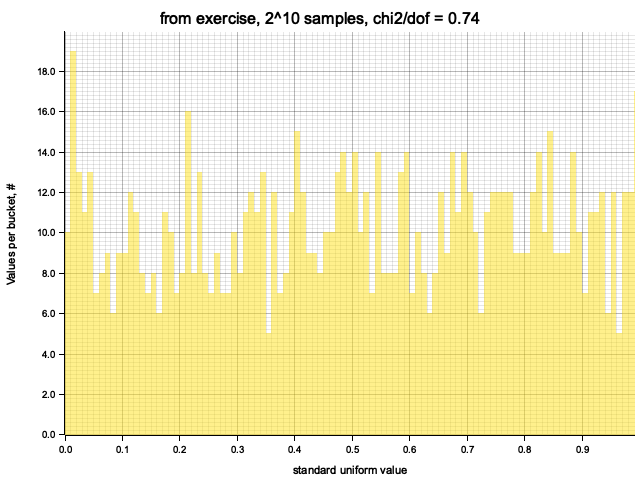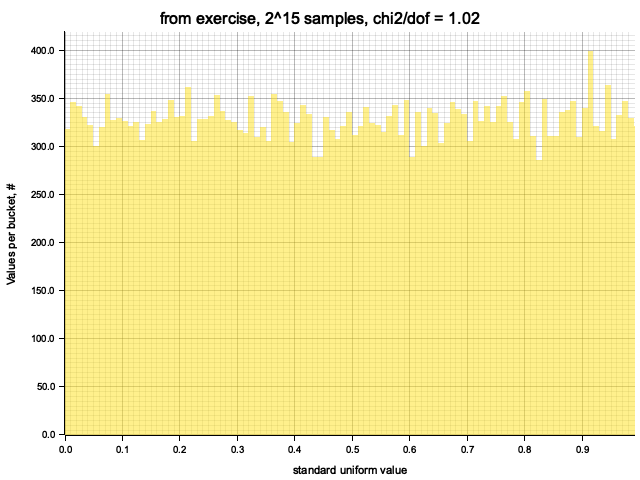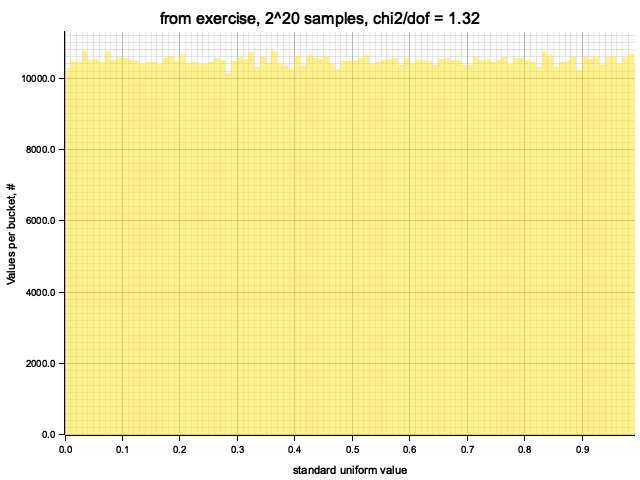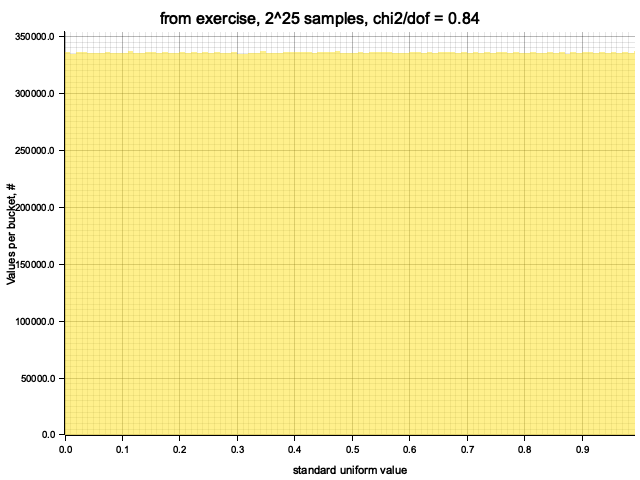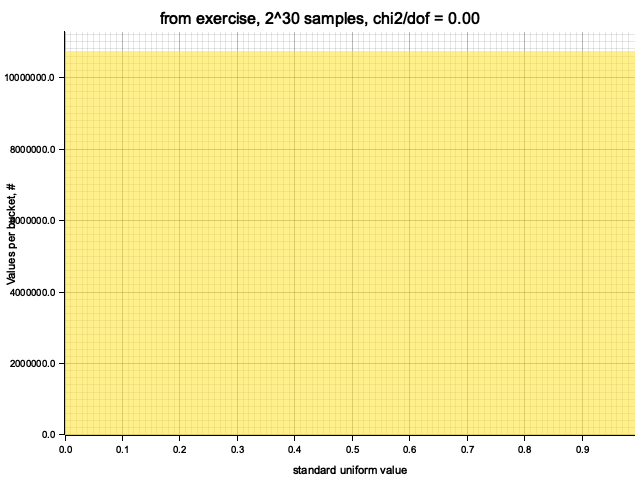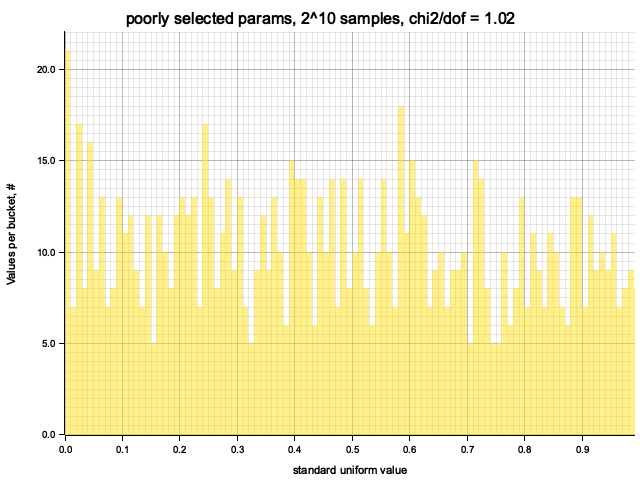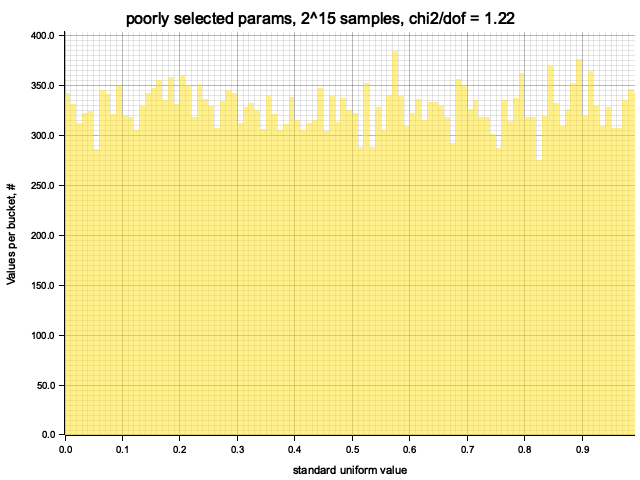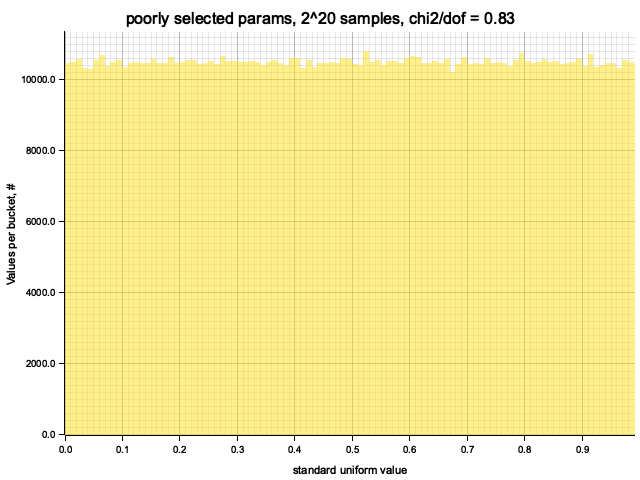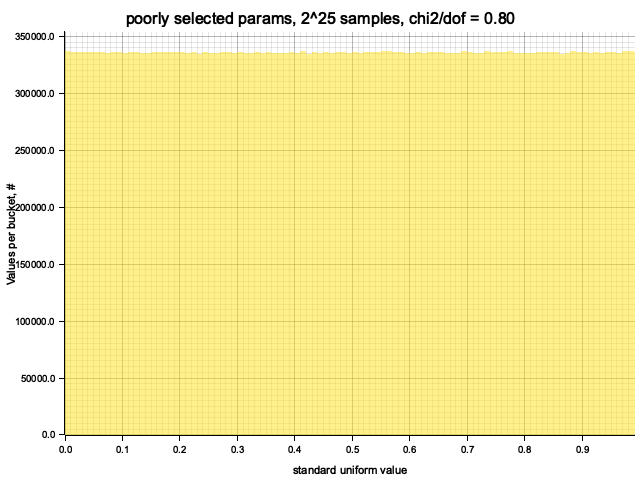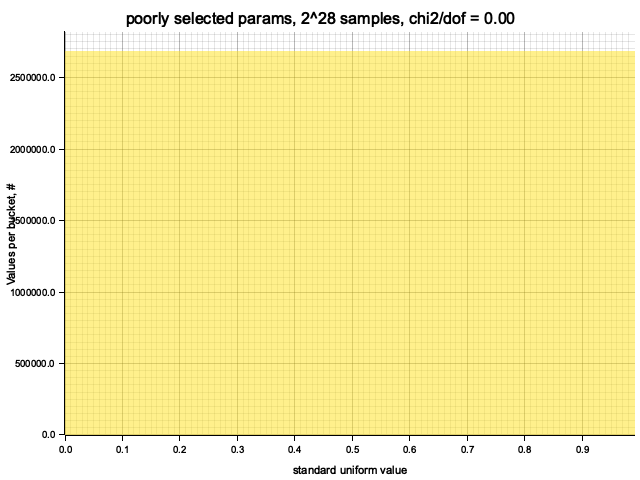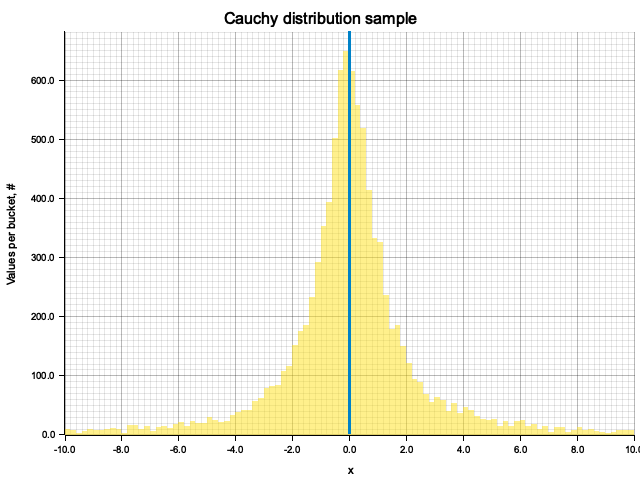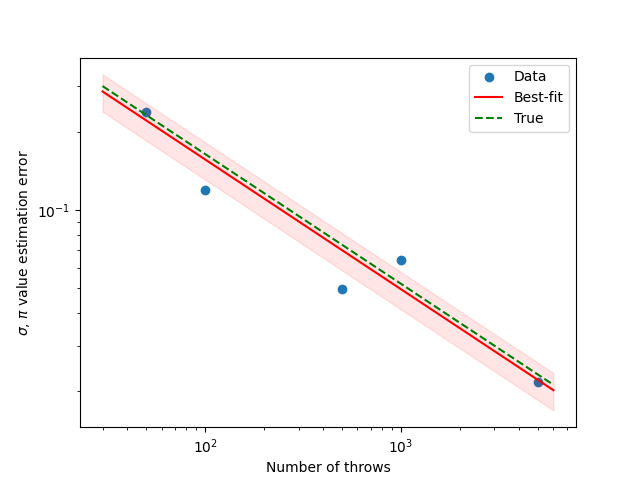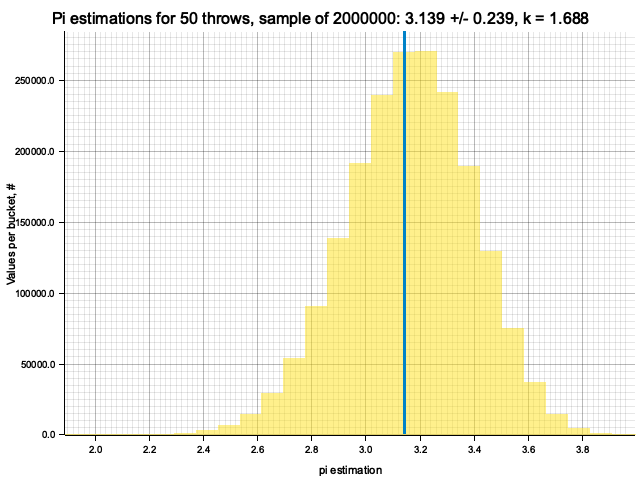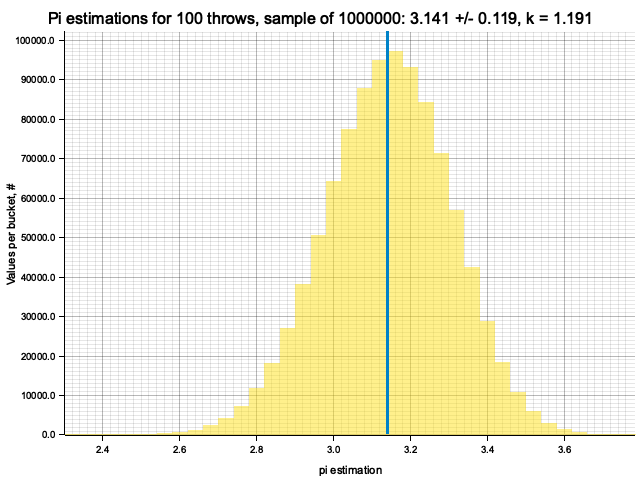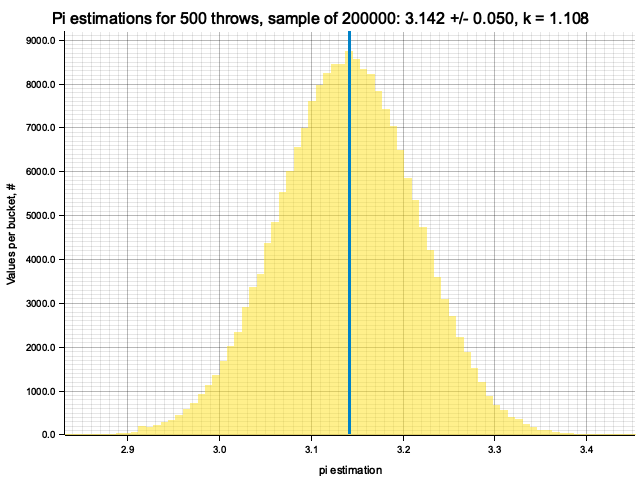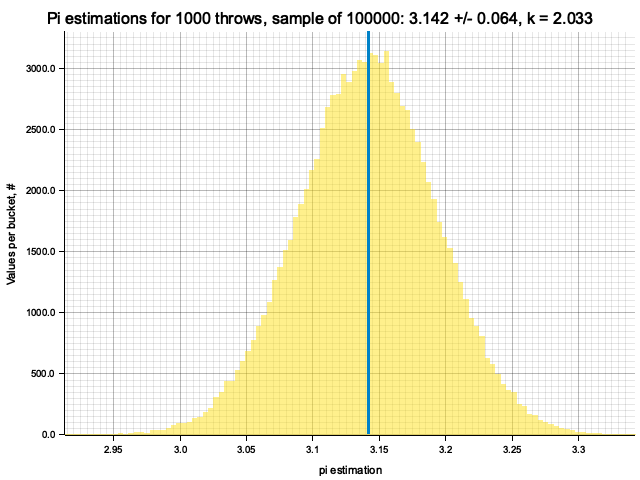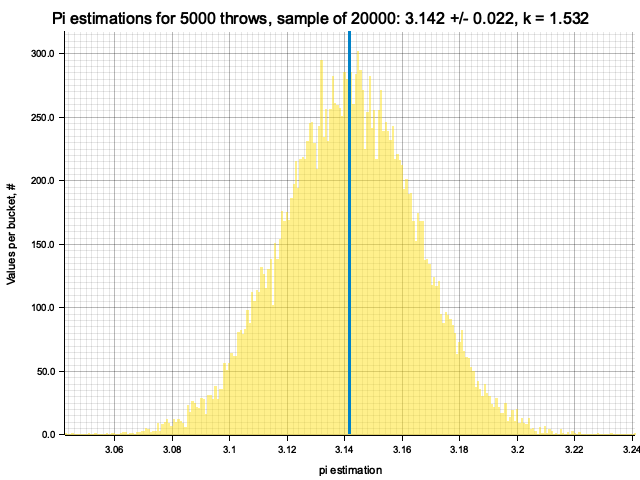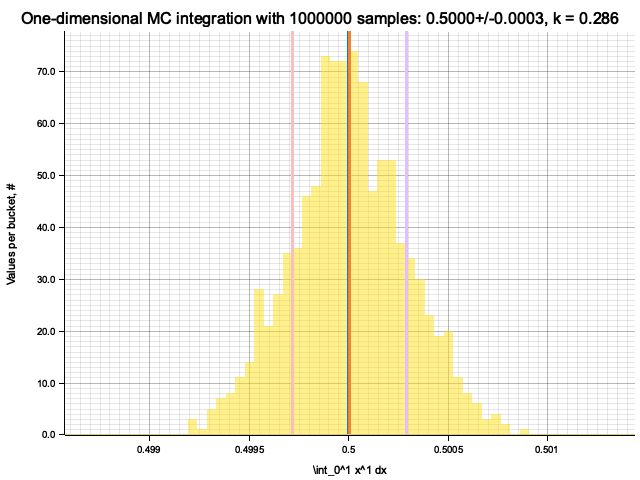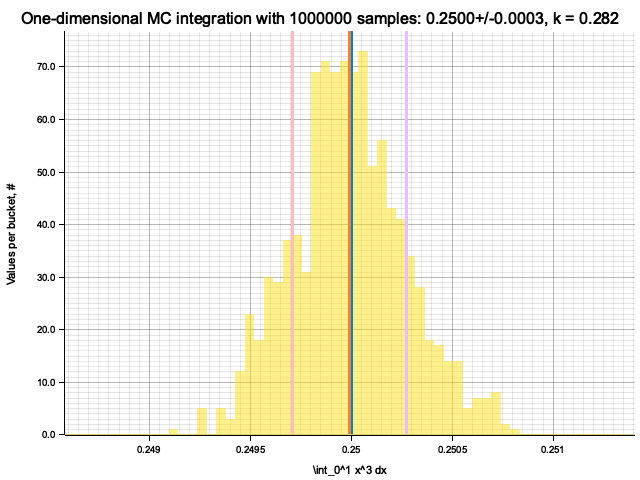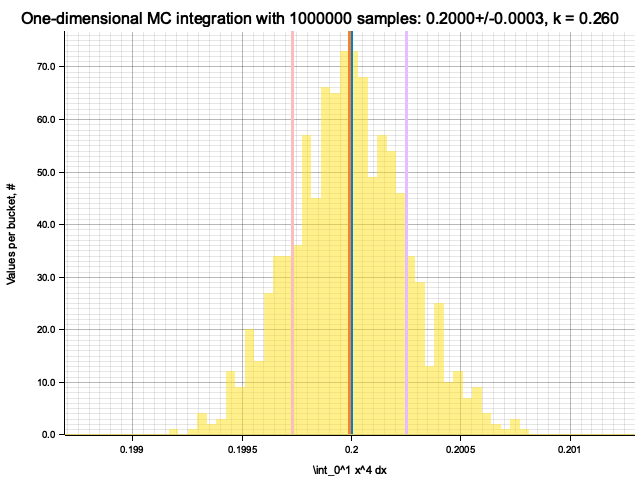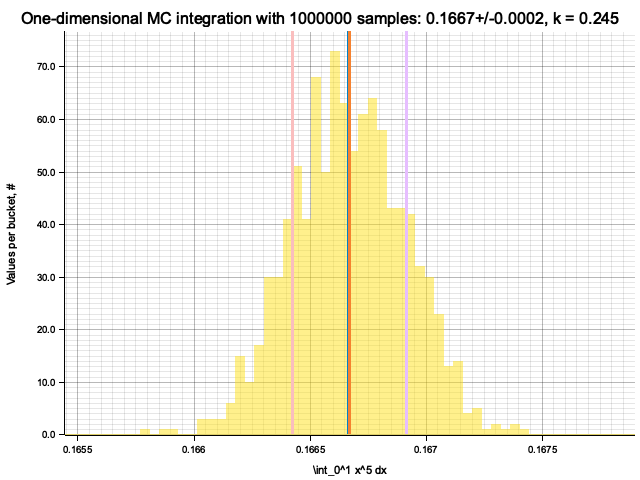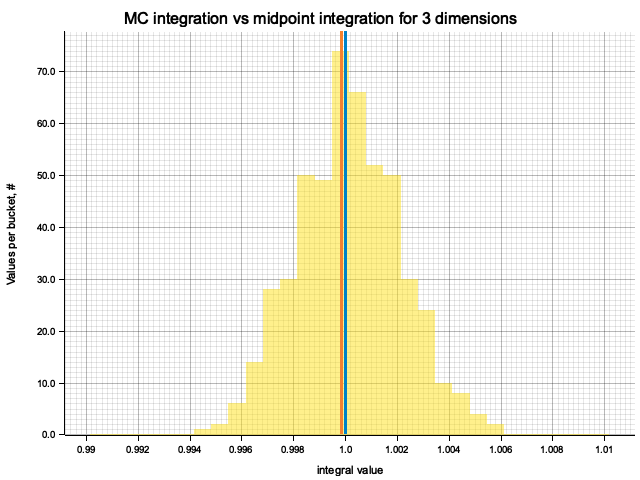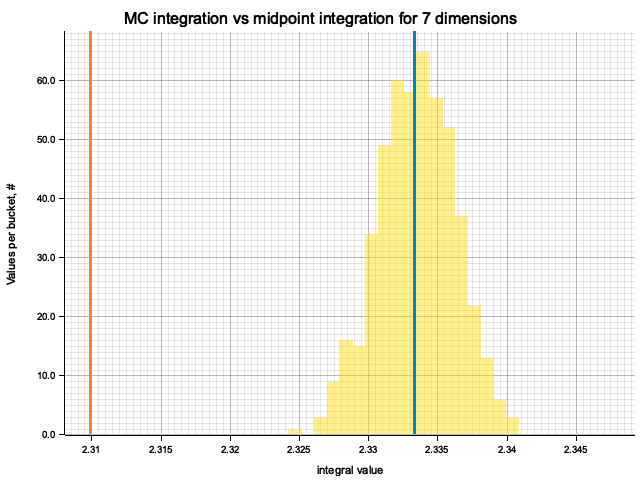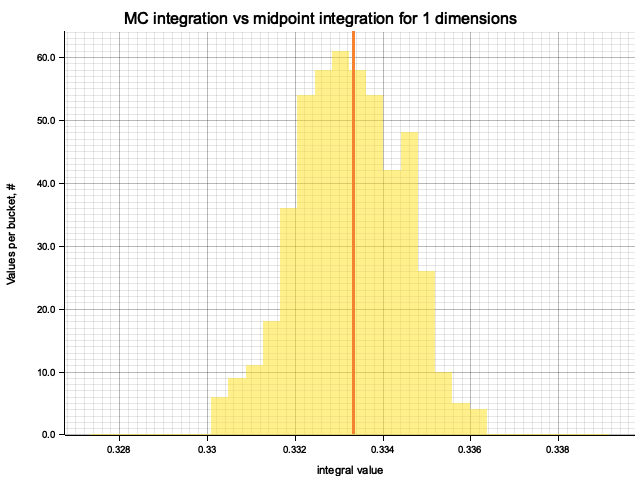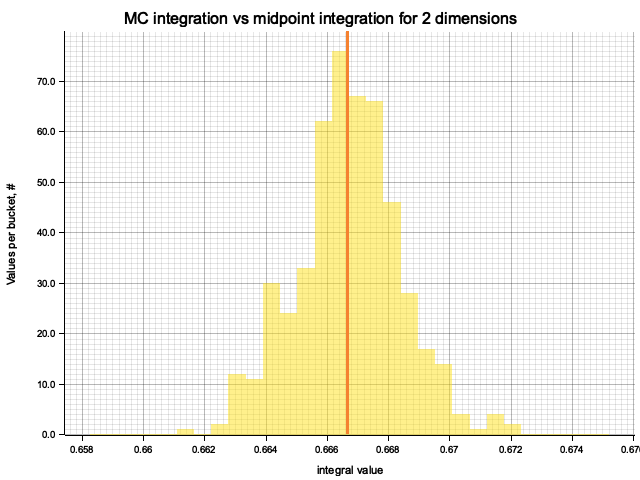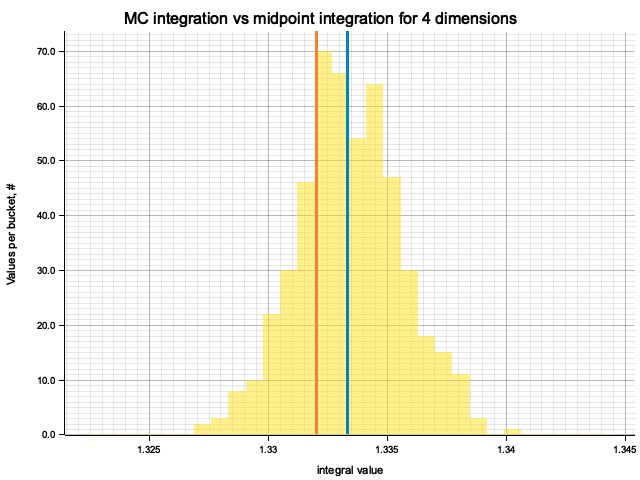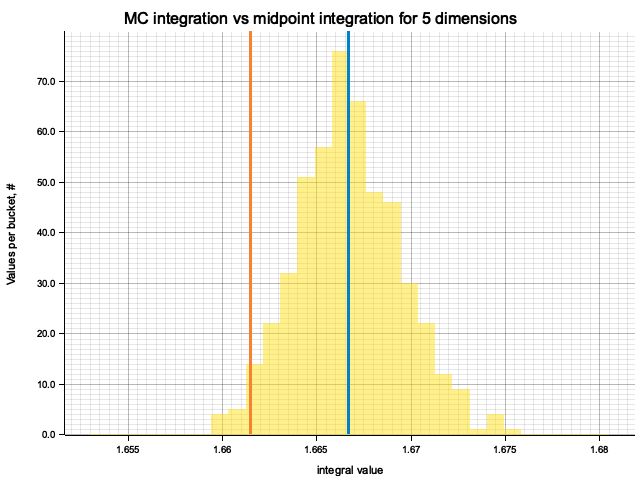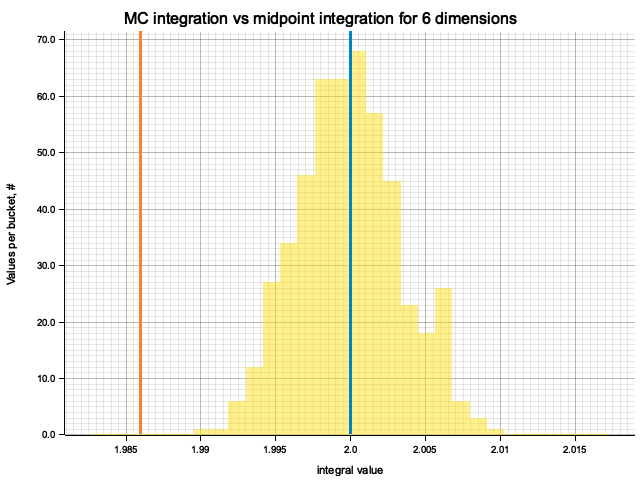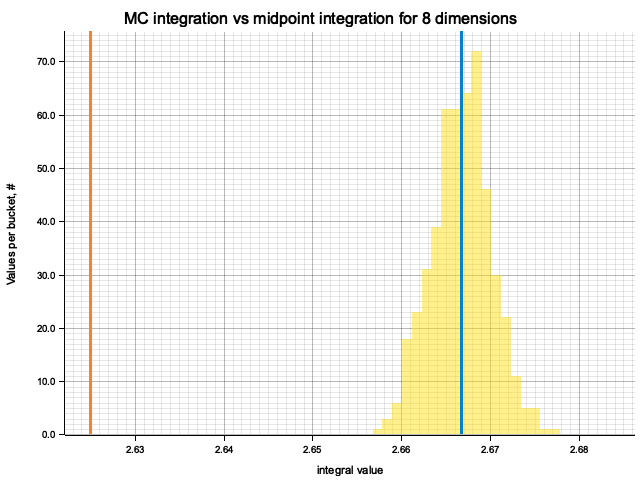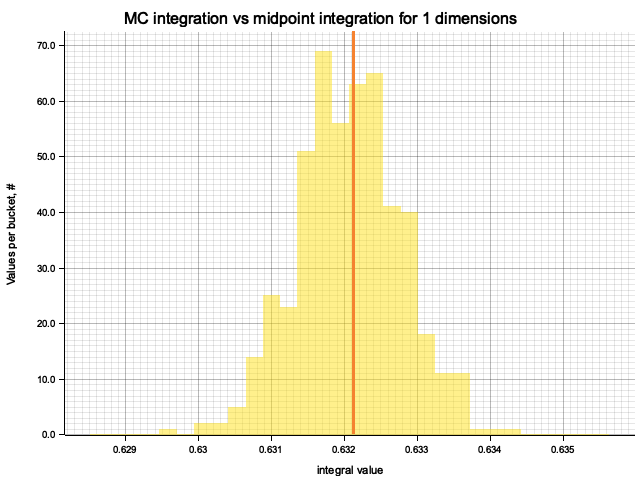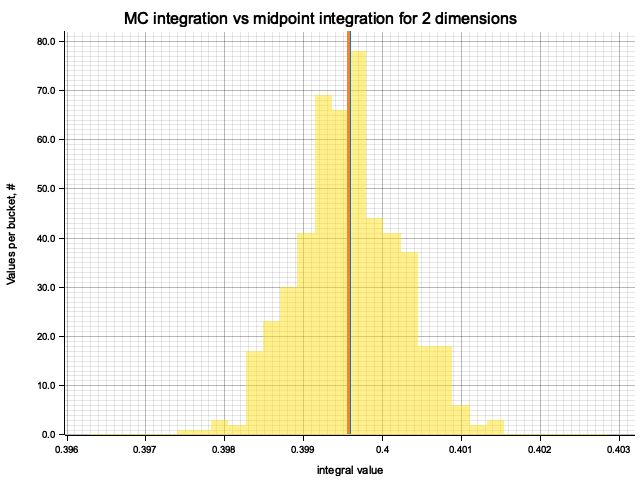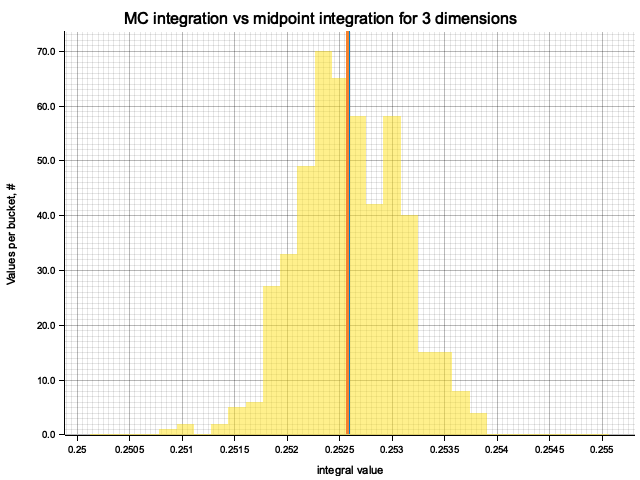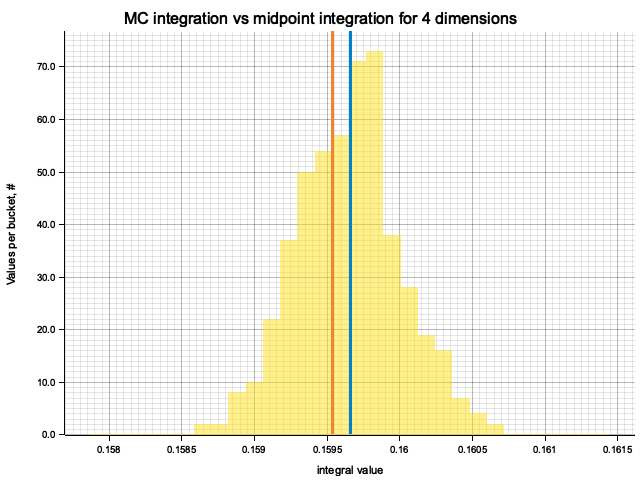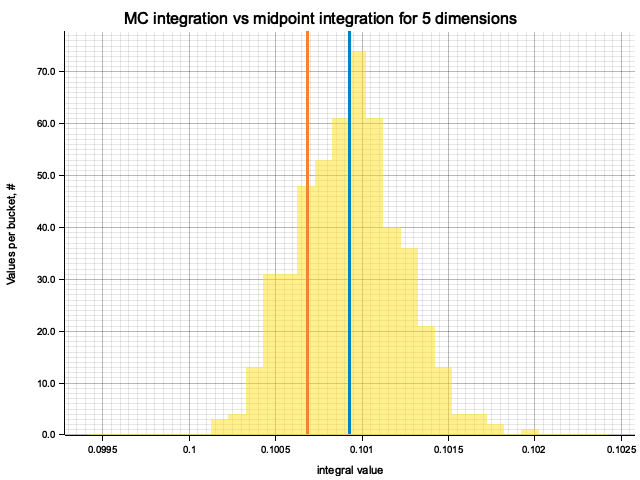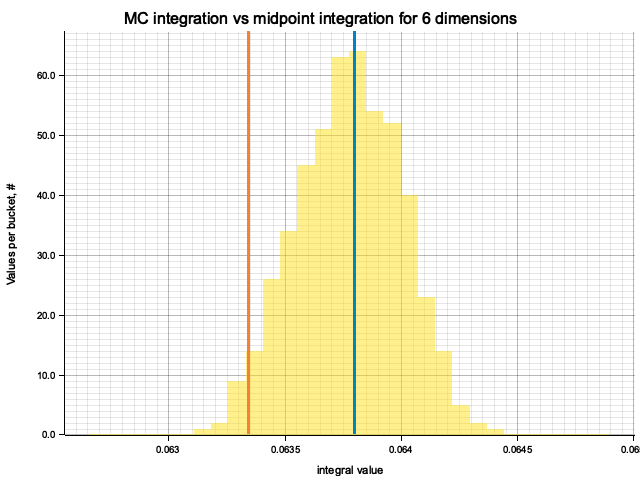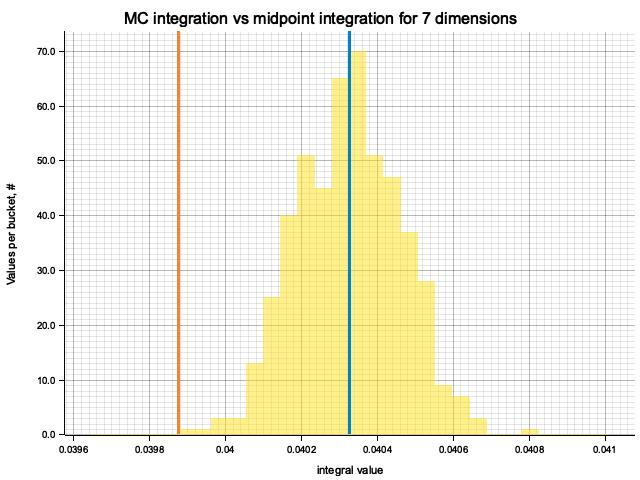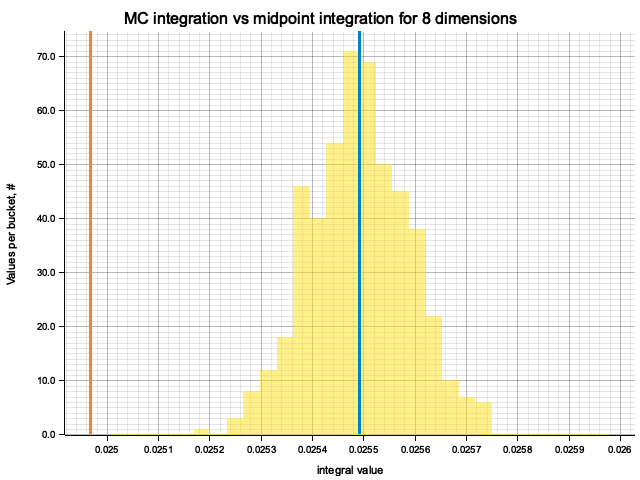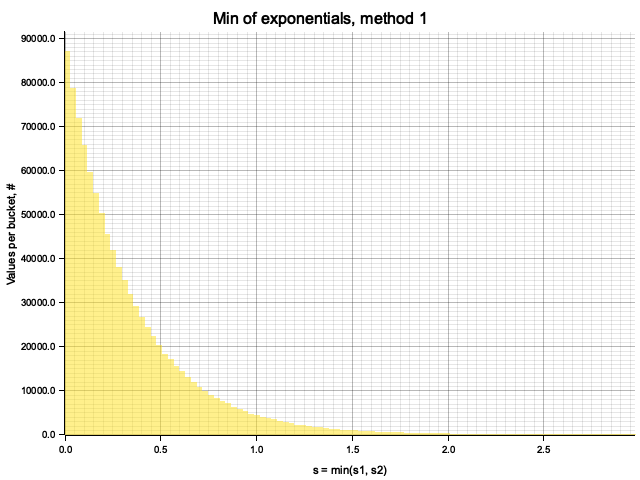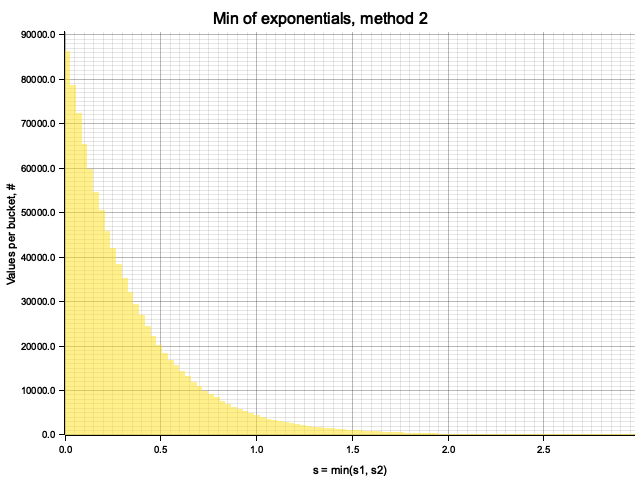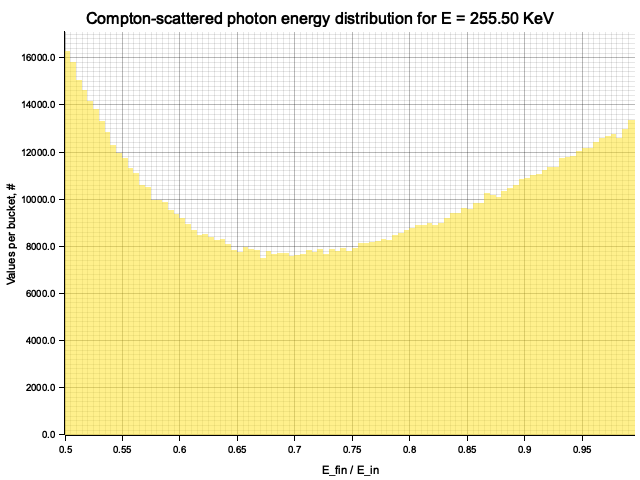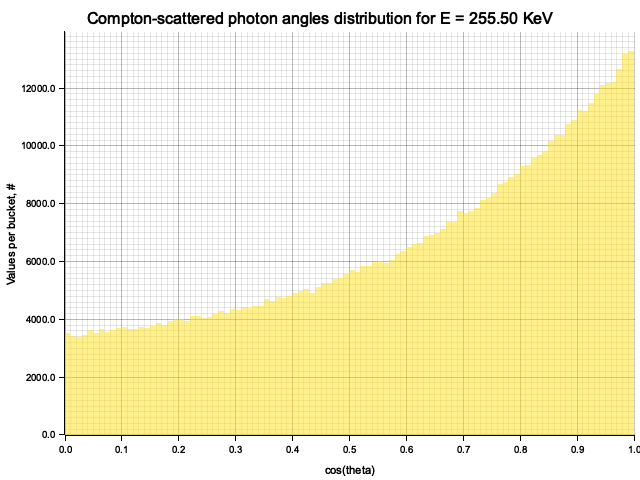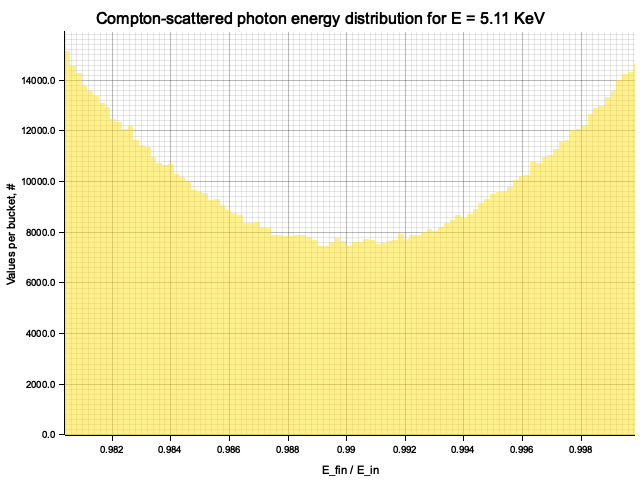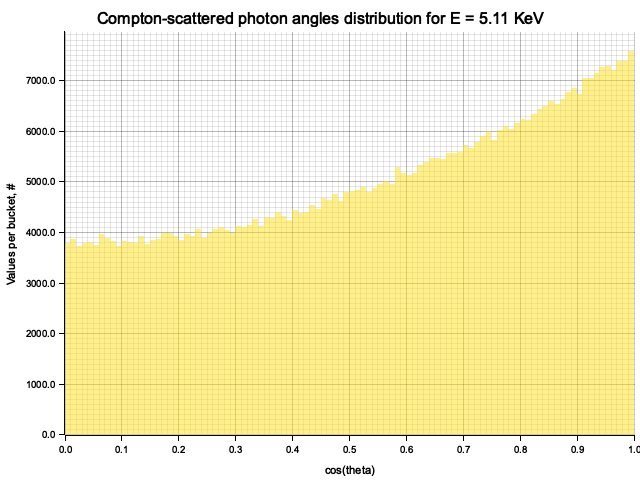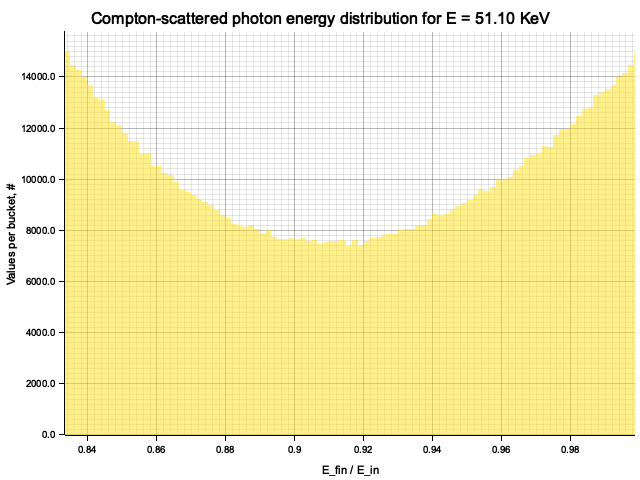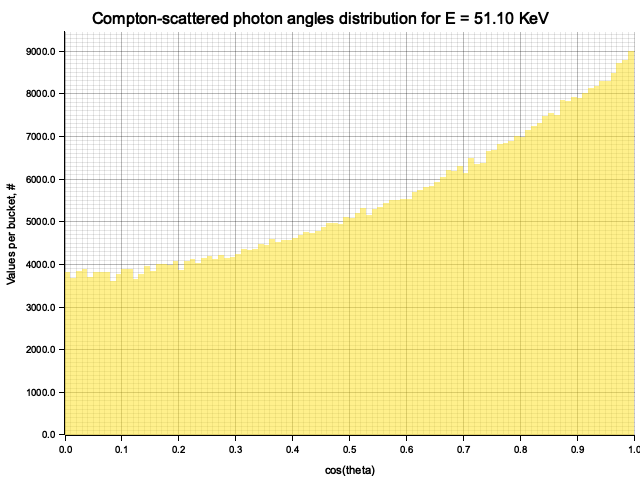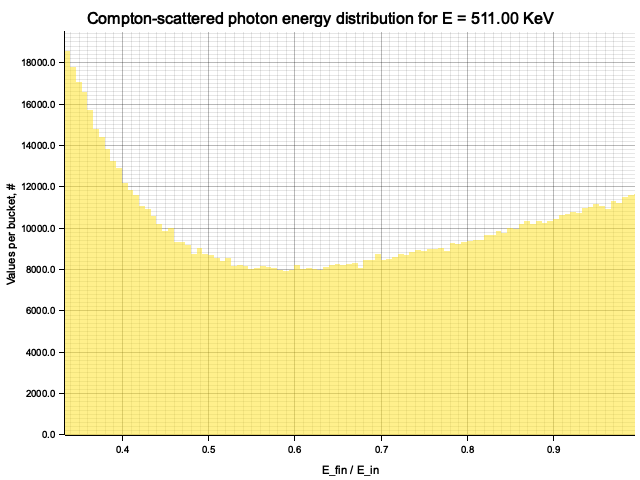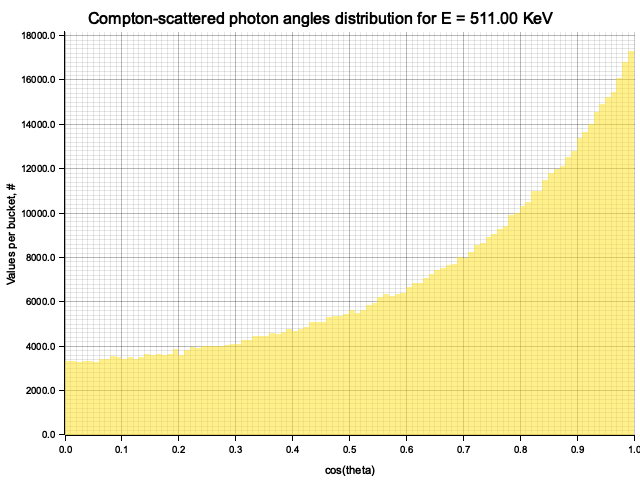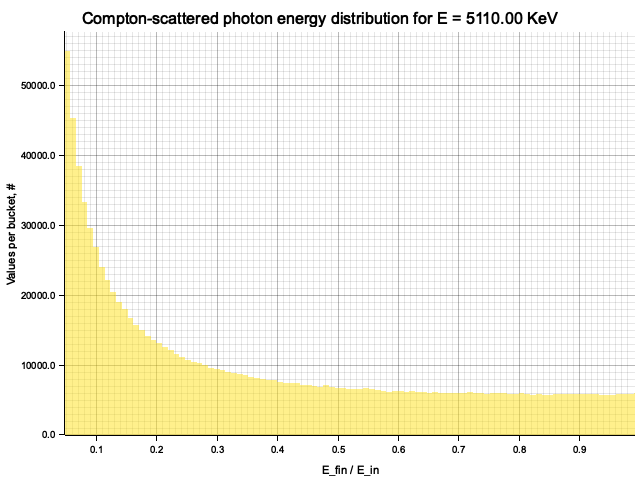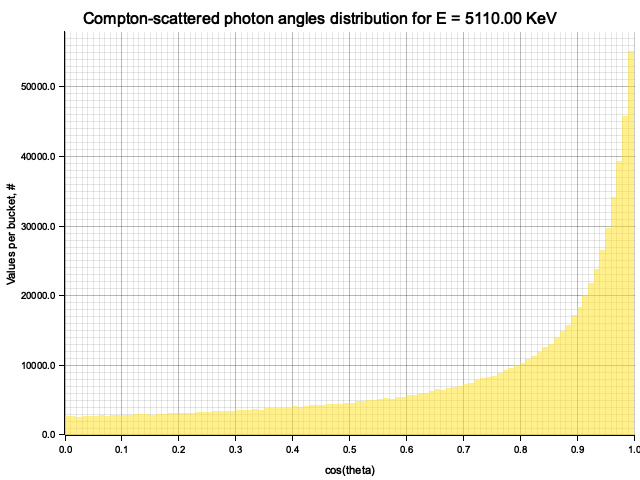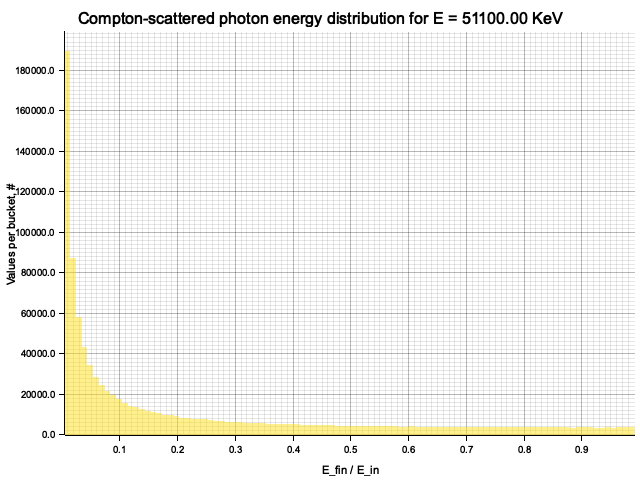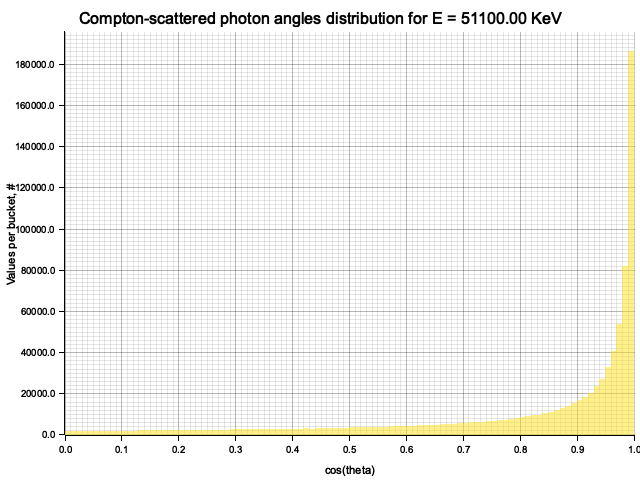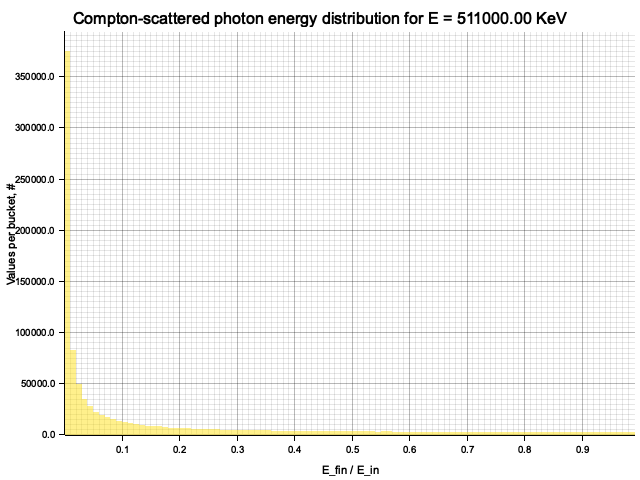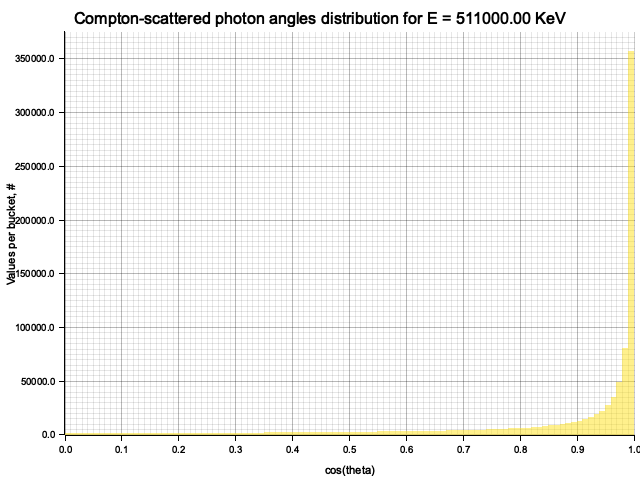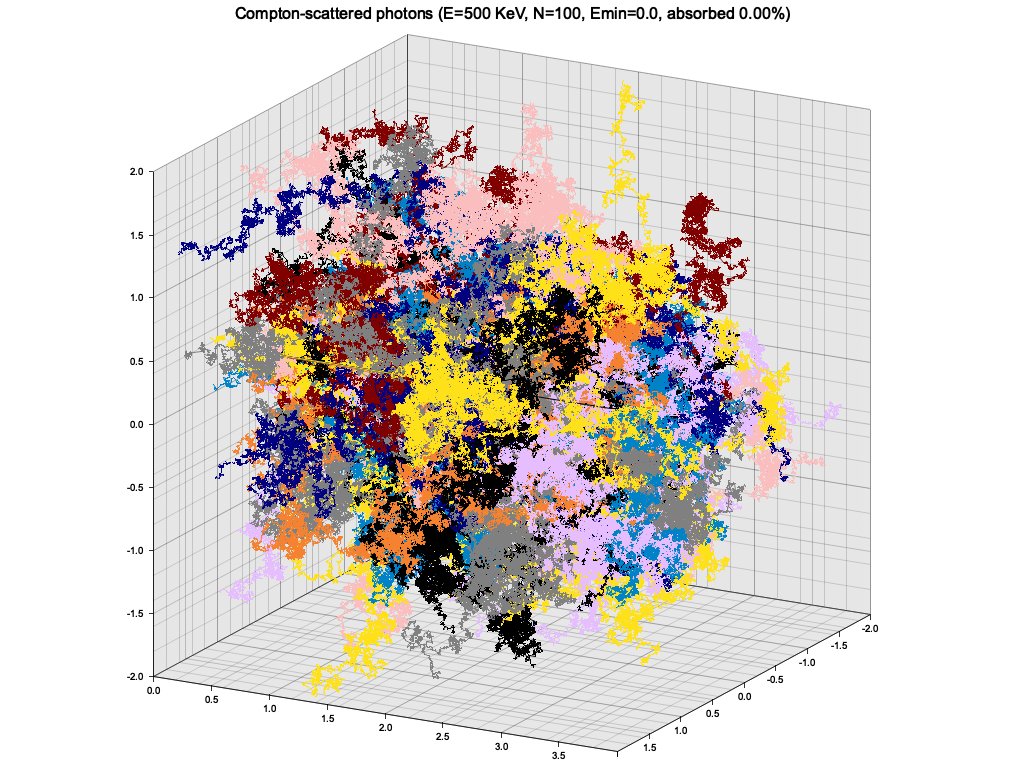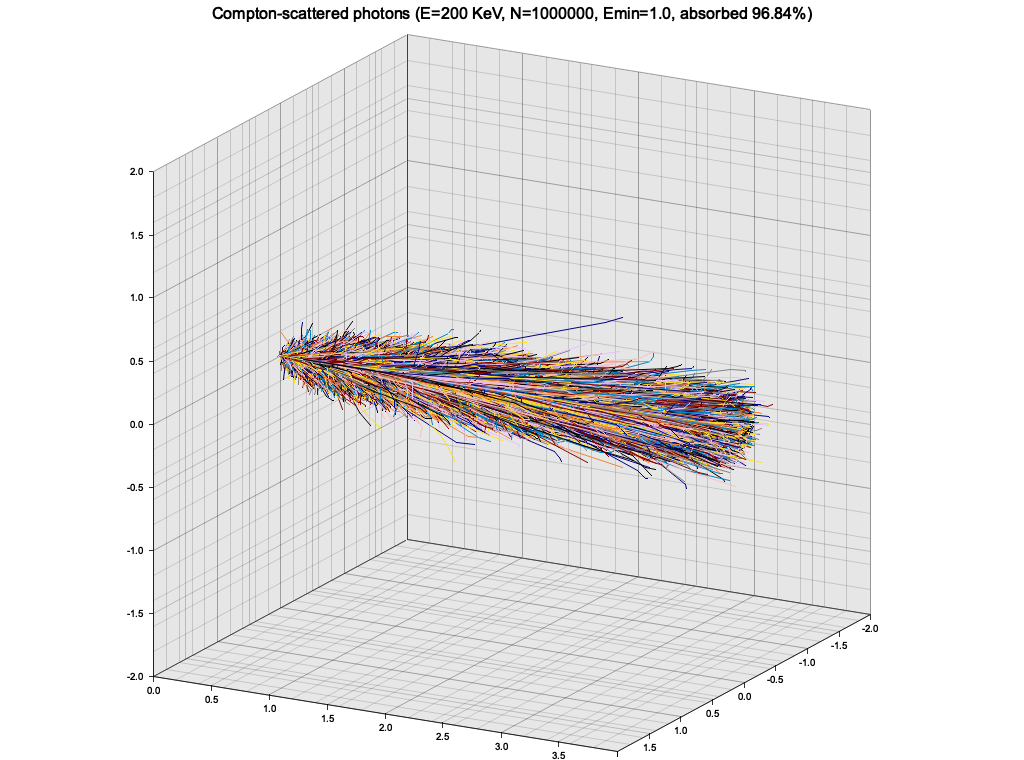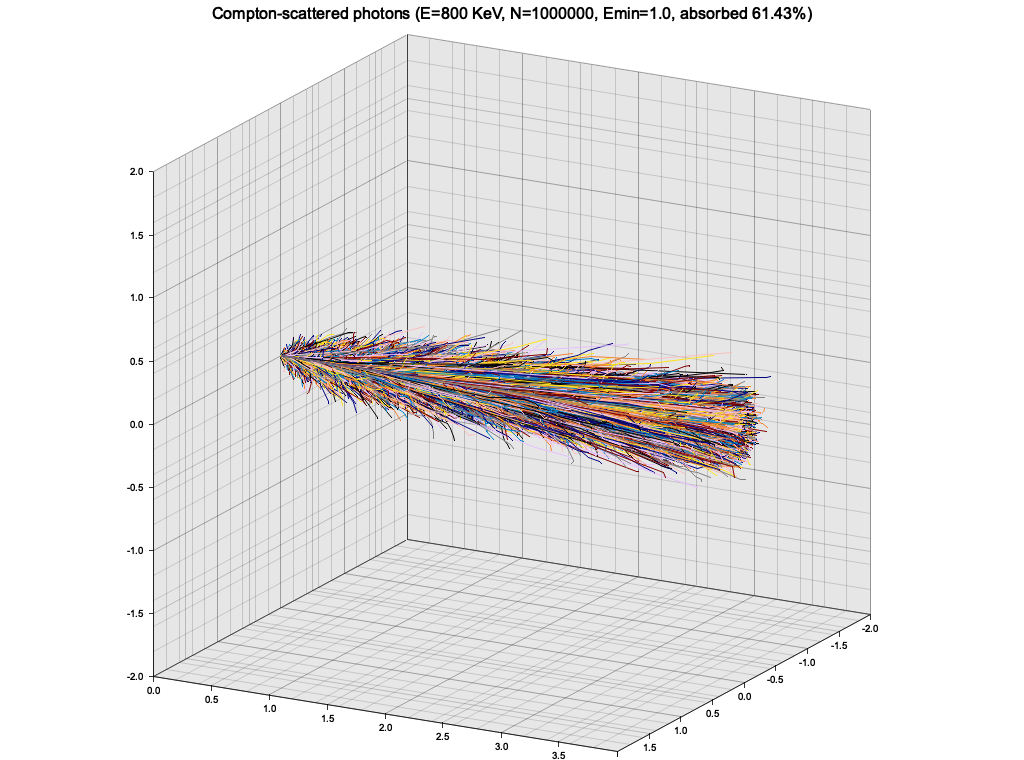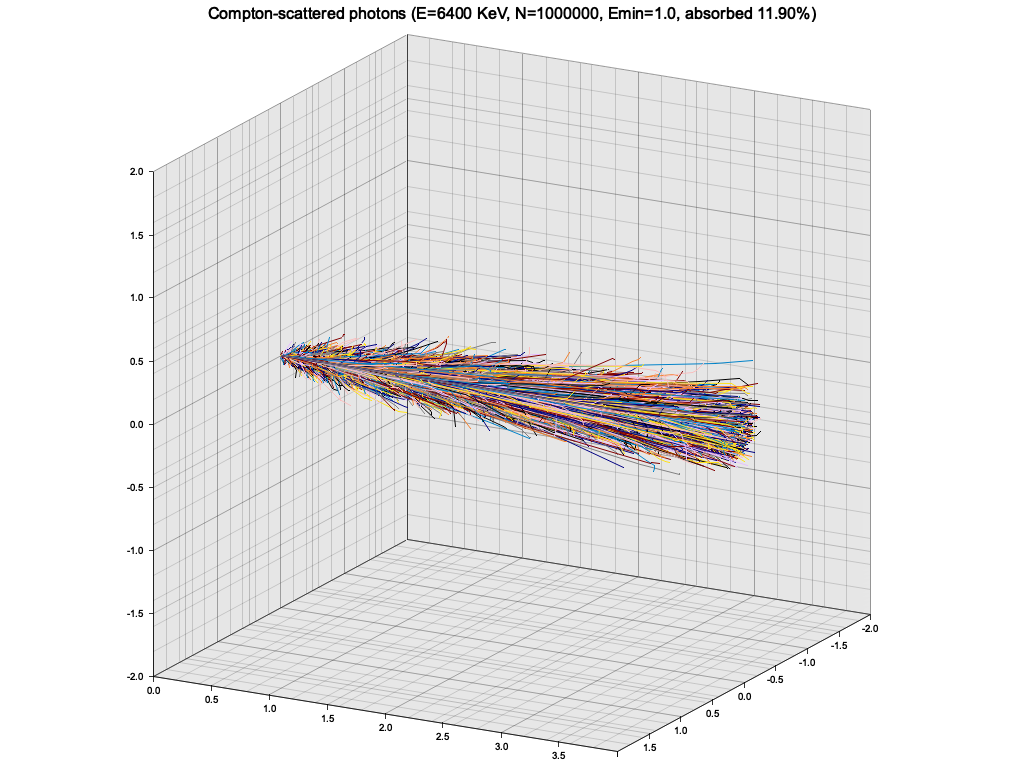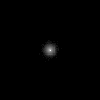Igor Vaiman
The exercises are done in Rust programming language. It's not widely used in physics community but hopefully can see wider adoption in the future. In combines access to low-level performance and fine-grained control with high-level features of modern programming languages. Its emphasis on memory safety, "fearless concurrency" and compile-time error detection might be helpful in parallelizing scientific tasks.
Source code
use crate::plot::{plot_histogram, AxLim};
use ndhistogram::{
axis::{Axis, UniformNoFlow},
ndhistogram, AxesTuple, Histogram, VecHistogram,
};
use num::{cast, traits::WrappingMul, Integer, NumCast};
use std::fmt::Display;
enum Modulus<T> {
TypeMax,
Value(T),
}
struct MCG<T: Integer + Display + WrappingMul + Copy> {
// Multiplicative Congruential Generator
init: T,
mult: T,
modulus: Modulus<T>,
// generator state
current: T,
step: usize,
}
impl<T: Integer + Display + WrappingMul + Copy> Iterator for MCG<T> {
type Item = T;
fn next(&mut self) -> Option<T> {
self.step += 1;
self.current = match self.modulus {
Modulus::TypeMax => self.current.wrapping_mul(&self.mult),
Modulus::Value(m) => (self.current * self.mult).rem(m),
};
if !self.current.is_zero() && self.current != self.init {
return Some(self.current);
} else {
return None;
}
}
}
impl<T: Integer + Display + WrappingMul + Copy> std::fmt::Display for MCG<T> {
fn fmt(&self, f: &mut std::fmt::Formatter<'_>) -> std::fmt::Result {
f.write_str(&format!(
"MCG {{ init: {}, mult: {} }}",
self.init, self.mult
))
}
}
impl<T: Integer + Display + WrappingMul + NumCast + Copy> MCG<T> {
fn new(init: T, mult: T, modulus: Modulus<T>) -> MCG<T> {
MCG {
init,
mult,
modulus,
current: init,
step: 0,
}
}
fn new_modulo_type_max(init: T, mult: T) -> MCG<T> {
MCG::new(init, mult, Modulus::TypeMax)
}
fn reset(&mut self) -> () {
self.current = self.init;
self.step = 0;
}
fn calculate_period(&mut self) -> usize {
self.reset();
for _ in self.into_iter() {} // exhausting the iterator
let period = self.step.to_owned();
self.reset();
return period;
}
fn run_tests(mut self, name: &str) -> () {
println!("\nTesting {}: {}", name, &self);
self.reset();
let mut timer = std::time::Instant::now();
let period = self.calculate_period();
println!(
"Full iteration: {} steps (log2(steps) = {}), took {:.2} seconds",
period,
(period as f64).log2(),
timer.elapsed().as_secs_f32()
);
for sample_size in [
Some(2usize.pow(10)),
Some(2usize.pow(15)),
Some(2usize.pow(20)),
Some(2usize.pow(25)),
None,
] {
println!("\nHistograming with sample size = {:?}", sample_size);
timer = std::time::Instant::now();
let mut hist = ndhistogram!(UniformNoFlow::new(100, 0.0, 1.0));
let scale = 1.0 / (u32::MAX as f64 - 1.0);
self.reset();
for (idx, i) in (&mut self).enumerate() {
hist.fill(&(scale * cast::<T, f64>(i).unwrap()));
if let Some(limit) = sample_size {
if idx == limit {
break;
}
}
}
println!(
"Histogram filled in {:.2} sec",
timer.elapsed().as_secs_f32()
);
let chi2_per_dof = uniform_chi2_per_dof(&hist, self.step);
println!("Histogram chi2 / d.o.f. = {}", chi2_per_dof);
let log2_size = (self.step as f64).log2();
plot_histogram(
&hist,
&format!(
"{}, 2^{:.0} samples, chi2/dof = {:.2}",
name, log2_size, chi2_per_dof
),
"standard uniform value",
&format!("out/ex1/{}-2^{:.0}.png", name, log2_size),
AxLim::FromData,
None,
)
.expect("Failed to plot histogram");
}
}
}
pub fn ex1() {
println!("\nEx 1: Uniform random sampling");
MCG::<u32>::new_modulo_type_max(987654321, 663608941).run_tests("from exercise");
MCG::<u32>::new_modulo_type_max(10, 9).run_tests("poorly selected params");
println!("\n\nEx 1.1: MINSTD algorithm");
let m = 2u64.pow(31) - 1;
let m_f64 = m as f64;
for seed in [1, 7u64.pow(2), 2u64.pow(4)] {
let mut minstd = MCG::<u64>::new(seed, 16807, Modulus::Value(m));
let start = std::time::Instant::now();
let period = minstd.calculate_period();
println!(
"Seed {:<10} -> period {:>9} ({:.2}% of range, calculated in {:.2} sec)",
seed,
period,
100.0 * (period as f64) / (m_f64),
start.elapsed().as_secs_f32(),
);
}
}
fn uniform_chi2_per_dof(
hist: &VecHistogram<AxesTuple<(UniformNoFlow<f64>,)>, f64>,
total_samples: usize,
) -> f64 {
let ax = &hist.axes().as_tuple().0;
let bin_count = ax.num_bins() as f64;
let bin_count_mean = total_samples as f64 / bin_count;
let mut chi2: f64 = 0.0;
for value in hist.values() {
// Pearson's chi squared for binned data
chi2 += (bin_count_mean - value).powi(2) / bin_count_mean;
}
return chi2 / bin_count;
}Execution log
Ex 1: Uniform random sampling
Testing from exercise: MCG { init: 987654321, mult: 663608941 }
Full iteration: 1073741824 steps (log2(steps) = 30), took 1.03 seconds
Histograming with sample size = Some(1024)
Histogram filled in 0.00 sec
Histogram chi2 / d.o.f. = 0.7402439024390247
Histogram has been saved to out/ex1/from exercise-2^10.png
Histograming with sample size = Some(32768)
Histogram filled in 0.00 sec
Histogram chi2 / d.o.f. = 1.0199697885196377
Histogram has been saved to out/ex1/from exercise-2^15.png
Histograming with sample size = Some(1048576)
Histogram filled in 0.00 sec
Histogram chi2 / d.o.f. = 1.3205646414140306
Histogram has been saved to out/ex1/from exercise-2^20.png
Histograming with sample size = Some(33554432)
Histogram filled in 0.09 sec
Histogram chi2 / d.o.f. = 0.8355132125165103
Histogram has been saved to out/ex1/from exercise-2^25.png
Histograming with sample size = None
Histogram filled in 3.01 sec
Histogram chi2 / d.o.f. = 0.000000016503036022602618
Histogram has been saved to out/ex1/from exercise-2^30.png
Testing poorly selected params: MCG { init: 10, mult: 9 }
Full iteration: 268435456 steps (log2(steps) = 28), took 0.25 seconds
Histograming with sample size = Some(1024)
Histogram filled in 0.00 sec
Histogram chi2 / d.o.f. = 1.0192682926829275
Histogram has been saved to out/ex1/poorly selected params-2^10.png
Histograming with sample size = Some(32768)
Histogram filled in 0.00 sec
Histogram chi2 / d.o.f. = 1.2246144221672923
Histogram has been saved to out/ex1/poorly selected params-2^15.png
Histograming with sample size = Some(1048576)
Histogram filled in 0.00 sec
Histogram chi2 / d.o.f. = 0.833544613318812
Histogram has been saved to out/ex1/poorly selected params-2^20.png
Histograming with sample size = Some(33554432)
Histogram filled in 0.09 sec
Histogram chi2 / d.o.f. = 0.7983531150712634
Histogram has been saved to out/ex1/poorly selected params-2^25.png
Histograming with sample size = None
Histogram filled in 0.75 sec
Histogram chi2 / d.o.f. = 0.00000009968876838725717
Histogram has been saved to out/ex1/poorly selected params-2^28.png
Ex 1.1: MINSTD algorithm
Seed 1 -> period 2147483646 (100.00% of range, calculated in 8.80 sec)
Seed 49 -> period 2147483646 (100.00% of range, calculated in 8.80 sec)
Seed 16 -> period 2147483646 (100.00% of range, calculated in 8.80 sec)
Total runtime: 31.67 sec
The exercise is to write a Multiplicative Congruent Generator (MCG) that produces
a stream of numbers according to the rule u32 Rust datatype) and use wrapping multiplication (which in Rust must be explicitly
asked for with a.wrapping_mul(b)). The MCG then has two parameters:
a multiplier
Results for MCG with initial value: 987654321 and multiplier: 663608941:
Full iteration: 1073741824 steps (log2(steps) = 30), took 1.03 seconds
Samples from this MCG with different sizes and with
I decided to try another, not specifically selected parameters to see the impact on the output.
With initial value: 10 and multiplier: 9 the cycle size is 4 times shorter,
Again, MINST is an MCG with multiplier
Source code
use ndhistogram::{axis::UniformNoFlow, ndhistogram, Histogram};
use rand::prelude::*;
use crate::plot::{plot_histogram, AxLim};
fn plot_cauchy_dist() {
let mut rng = rand::thread_rng();
let sample_size = 10000;
let sample: Vec<f64> = (0..sample_size)
// inverse CDF C^-1(t) = tan(pi*(t - 1/2))
.map(|_| (std::f64::consts::PI * (rng.gen::<f64>() - 0.5)).tan())
.collect();
let mut hist = ndhistogram!(UniformNoFlow::new(100, -10.0, 10.0));
sample.iter().map(|s| hist.fill(s)).count();
plot_histogram(
&hist,
"Cauchy distribution sample",
"x",
"out/ex2/cauchy.png",
AxLim::Range(-10.0, 10.0),
Some(vec![0.0]),
)
.expect("Failed to plot histogram");
}
const TWO_PI: f32 = 2.0 * std::f32::consts::PI;
fn sample_circle_analytic(rng: &mut ThreadRng) -> (f32, f32) {
let t1: f32 = rng.gen();
let t2: f32 = rng.gen();
let sqrt_t1 = t1.sqrt();
return (sqrt_t1 * (TWO_PI * t2).cos(), sqrt_t1 * (TWO_PI * t2).sin());
}
fn sample_circle_rejection(rng: &mut ThreadRng) -> (f32, f32) {
loop {
let x = 2.0 * rng.gen::<f32>() - 1.0;
let y = 2.0 * rng.gen::<f32>() - 1.0;
if x.powi(2) + y.powi(2) <= 1.0 {
return (x, y);
}
}
}
pub fn ex2() {
println!("Plotting Cauchy distribution sample");
plot_cauchy_dist();
let sample_size = 100_000_000;
let mut rng = rand::thread_rng();
println!("\nSampling {} points inside the unit circle", sample_size);
println!("Analytic method...");
let mut timer = std::time::Instant::now();
for _ in 0..sample_size {
sample_circle_analytic(&mut rng);
}
println!("... done in {:.2} sec", timer.elapsed().as_secs_f32());
println!("Rejection method...");
timer = std::time::Instant::now();
for _ in 0..sample_size {
sample_circle_rejection(&mut rng);
}
println!("... done in {:.2} sec", timer.elapsed().as_secs_f32());
}Execution log
Plotting Cauchy distribution sample
Histogram has been saved to out/ex2/cauchy.png
Sampling 100000000 points inside the unit circle
Analytic method...
... done in 1.08 sec
Rejection method...
... done in 1.95 sec
Total runtime: 3.05 sec
Inverted CDF for Cauchy distribution is:
Using it, we obtain a sample:
In principle, the result could depend on compiler optimizations. In Rust, optimizations are
controlled by --release flag. Both with and without this flag, the analytic method works
faster, but optimization makes its lead much more pronounced:
| Analytic | Rejection | |
|---|---|---|
| Debug build (non-optimized) | 52.78 | 65.49 |
| Release build (optimized) | 1.07 | 1.94 |
Source code
use std::collections::HashSet;
use crate::{plot::AxLim, utils::mean_std};
use itertools::Itertools;
use ndhistogram::{axis::UniformNoFlow, ndhistogram, Histogram};
use rand::prelude::*;
use crate::plot::{plot_histogram, plot_lines, Line};
const PI32: f32 = std::f32::consts::PI;
const PI64: f64 = std::f64::consts::PI;
fn throw_into_circle(rng: &mut ThreadRng) -> bool {
let x = 2.0 * rng.gen::<f32>() - 1.0;
let y = 2.0 * rng.gen::<f32>() - 1.0;
return (x.powi(2) + y.powi(2)) < 1.0;
}
fn estimate_pi(thrown_inside: usize, thrown_total: usize) -> f32 {
4.0 * (thrown_inside as f32 / thrown_total as f32)
}
fn produce_pi_series(
rng: &mut ThreadRng,
total_steps: usize,
record_steps: Option<usize>,
logging: bool,
) -> Vec<(f32, f32)> {
let mut steps_to_record: HashSet<usize> = HashSet::new();
if let Some(record_steps) = record_steps {
let log_min = 1.0;
let log_max = (total_steps as f32).log10();
let log_range = log_max - log_min;
let log_linspace = (0..record_steps)
.map(|ibin| log_min + log_range * (ibin as f32) / (record_steps as f32));
for sr in log_linspace.into_iter().map(|log| log.powi(10) as usize) {
steps_to_record.insert(sr);
}
}
let mut pi_estimates: Vec<(f32, f32)> = Vec::new();
let mut thrown_inside: usize = 0;
for step in 1..total_steps + 1 {
if throw_into_circle(rng) {
thrown_inside += 1;
}
if steps_to_record.contains(&step) {
let logstep = (step as f32).log10();
pi_estimates.push((logstep, estimate_pi(thrown_inside, step)))
}
}
if record_steps.is_none() {
pi_estimates.push((
(total_steps as f32).log10(),
estimate_pi(thrown_inside, total_steps),
));
}
if logging {
println!(
"Thrown {} points, recorded {} pi estimation(s)",
total_steps,
pi_estimates.len()
);
}
pi_estimates
}
fn plot_pi_series(rng: &mut ThreadRng) {
let total_steps: usize = 10_000_000;
let record_steps: usize = 200;
let pi_samples: Vec<Vec<(f32, f32)>> = (0..5)
.map(|_| produce_pi_series(rng, total_steps, Some(record_steps), true))
.collect();
let envelope_line = [1, total_steps + 1]
.into_iter()
.map(|step| {
let logstep = (step as f32).log10();
(logstep, -logstep / 2.0) // 1/sqrt(step) => - log(step) / 2
})
.collect_vec();
plot_lines(
pi_samples
.into_iter()
.enumerate()
.map(|(idx, pi_series)| Line {
data: pi_series
.iter()
.map(|(logstep, pi_est)| (*logstep, (PI32 - pi_est).abs().log10()))
.collect(),
label: format!("Run #{}", idx),
point_size: Some(2),
})
.chain([Line {
data: envelope_line,
label: "Envelope".to_owned(),
point_size: None,
}])
.collect(),
"Pi value estimation convergence",
"log_10(step)",
"log_10(|error|)",
"out/ex3/pi.png",
)
.expect("Failed to plot line");
}
fn estimate_pi_error(rng: &mut ThreadRng) {
for total_throws in [50, 100, 500, 1000, 5000] {
let sample_size = 1_000_000 * 100 / total_throws; // to keep time reasonable
let pi_est_sample: Vec<f32> = (0..sample_size)
.map(|_| {
produce_pi_series(rng, total_throws, None, false)
.last()
.unwrap()
.1
})
.collect();
let (mu, sigma) = mean_std(&pi_est_sample);
let k_est = sigma * (total_throws as f32).sqrt();
println!(
"N = {}, pi estimation: {:e} +/- {:e}; k = sigma*sqrt(N) = {:.5}",
total_throws, mu, sigma, k_est,
);
println!("{}, {}", total_throws, sigma);
let sqrt_throws = (total_throws as f64).sqrt();
// 10 / sqrt(N) scaling is ad hoc
let low = PI64 - 10.0 / sqrt_throws;
let high = PI64 + 10.0 / sqrt_throws;
// it makes no sense to make more bins than max precision, limited by total throws
let bins = ((high - low) * total_throws as f64 / 4.0) as usize;
println!(
"Histogram params for {} throws: range {:.4}..{:.4}, {} bins",
total_throws, low, high, bins
);
let mut hist = ndhistogram!(UniformNoFlow::new(bins, low, high));
for value in pi_est_sample {
hist.fill(&(value as f64));
}
plot_histogram(
&hist,
&format!(
"Pi estimations for {} throws, sample of {}: {:.3} +/- {:.3}, k = {:.3}",
total_throws, sample_size, mu, sigma, k_est,
),
"pi estimation",
&format!("out/ex3/pi-est-distribution-{}-throws.png", total_throws),
AxLim::FromData,
Some(vec![PI64]),
)
.expect("Failed to plot histogram");
}
}
pub fn ex3() {
let mut rng = rand::thread_rng();
plot_pi_series(&mut rng);
estimate_pi_error(&mut rng);
}Execution log
Thrown 5000000 points, recorded 500 pi estimation(s)
Thrown 5000000 points, recorded 500 pi estimation(s)
Thrown 5000000 points, recorded 500 pi estimation(s)
Plot has been saved to out/ex3/pi.png
Sample moments: 3.139188e0 +/- 2.3990864e-1, k = sigma*sqrt(N) = 1.69641
Histogram params for 50 throws: range 1.7274..4.5558, 35 bins
Histogram has been saved to out/ex3/pi-est-distribution-50-throws.png
Sample moments: 3.140801e0 +/- 1.17763884e-1, k = sigma*sqrt(N) = 1.17764
Histogram params for 100 throws: range 2.1416..4.1416, 50 bins
Histogram has been saved to out/ex3/pi-est-distribution-100-throws.png
Sample moments: 3.1418881e0 +/- 4.7691856e-2, k = sigma*sqrt(N) = 1.06642
Histogram params for 500 throws: range 2.6944..3.5888, 111 bins
Histogram has been saved to out/ex3/pi-est-distribution-500-throws.png
Sample moments: 3.1414034e0 +/- 6.4998284e-2, k = sigma*sqrt(N) = 2.05543
Histogram params for 1000 throws: range 2.8254..3.4578, 158 bins
Histogram has been saved to out/ex3/pi-est-distribution-1000-throws.png
Sample moments: 3.1415582e0 +/- 2.1306079e-2, k = sigma*sqrt(N) = 1.50657
Histogram params for 5000 throws: range 3.0002..3.2830, 353 bins
Histogram has been saved to out/ex3/pi-est-distribution-5000-throws.png
Total runtime: 5.93 sec
To check the convergence, I plot the logarithm of absolute estimation error
vs. the number of throws. All traces converge (error decreases) according to
a
To estimate the error, we can fix the number of throws
Using the best-fit value of
Source code
use itertools::Itertools;
use ndhistogram::{axis::UniformNoFlow, ndhistogram, Histogram};
use rand::prelude::*;
use crate::{
plot::{plot_histogram, AxLim},
utils::mean_std,
};
fn onedim_mc_integral(rng: &mut ThreadRng, pow: i32, sample_count: usize) -> f32 {
let n = sample_count as f32;
(0..sample_count)
.map(|_| rng.gen::<f32>().powi(pow))
.chunks(1000)
.into_iter()
.map(|chunk| chunk.sum::<f32>() / n)
.sum::<f32>() // *(b - a), but in this case it's 1
}
fn plot_onedim_integral_mc_distributions(rng: &mut ThreadRng) {
for pow in [1, 2, 3, 4, 5] {
println!("\nIntegrating x^{}", pow);
let sample_count = 1_000_000;
let estimations_count = 1_000;
let estimations = (0..estimations_count)
.map(|_| onedim_mc_integral(rng, pow, sample_count))
.collect::<Vec<_>>();
let (mu, sigma) = mean_std(&estimations);
println!("Estimate sigma: {}", sigma);
let k_est = sigma * (sample_count as f32).sqrt();
let true_value = 1.0 / (1.0 + pow as f64);
let lo = (mu - 5.0 * sigma) as f64;
let hi = (mu + 5.0 * sigma) as f64;
let mut hist = ndhistogram!(UniformNoFlow::new(60, lo, hi));
for value in estimations {
hist.fill(&(value as f64));
}
plot_histogram(
&hist,
&format!(
"One-dimensional MC integration with {} samples: {:.4}+/-{:.4}, k = {:.3}",
sample_count, mu, sigma, k_est
),
&format!("\\int_0^1 x^{} dx", pow),
&format!(
"out/ex5/1/x^{}-mc-integral-{}-samples.png",
pow, sample_count
),
AxLim::Range(lo, hi),
Some(vec![
true_value,
mu as f64,
(mu - sigma) as f64,
(mu + sigma) as f64,
]),
)
.expect("Failed to plot histogram");
}
}
enum Integrand {
SquaresSum,
ExpProduct,
}
impl Integrand {
pub fn name(&self) -> &str {
match self {
Integrand::SquaresSum => "squares-sum",
Integrand::ExpProduct => "exp-product",
}
}
pub fn true_integral(&self, ndim: usize) -> f64 {
match self {
Integrand::SquaresSum => (ndim as f64) / 3.0,
Integrand::ExpProduct => (1.0 - 1.0 / std::f64::consts::E).powi(ndim as i32),
}
}
pub fn random_value(&self, rng: &mut ThreadRng, ndim: usize) -> f32 {
let random_point: Vec<f32> = (0..ndim).map(|_| rng.gen::<f32>()).collect();
self.value_at(random_point.iter())
}
pub fn value_at<'a>(&self, point: impl Iterator<Item = &'a f32>) -> f32 {
match self {
Integrand::SquaresSum => point.map(|coord| (*coord).powi(2)).sum::<f32>(),
Integrand::ExpProduct => point.map(|coord| (-*coord).exp()).product::<f32>(),
}
}
}
fn ndim_mc_integral(
rng: &mut ThreadRng,
ndim: usize,
sample_count: usize,
integrand: &Integrand,
) -> f32 {
let n = sample_count as f32;
let func_mean = (0..sample_count)
.map(|_| integrand.random_value(rng, ndim) / n)
.sum::<f32>();
func_mean // times hypercube volume, but in this case it's 1
}
fn ndim_midpoint_integral(ndim: usize, cells_per_dim: usize, integrand: &Integrand) -> f32 {
let step = 1.0 / (cells_per_dim as f32);
let cell_volume = step.powi(ndim as i32);
let onedim_cell_centers = (0..cells_per_dim)
.map(|idx| step * (idx as f32 + 0.5))
.collect::<Vec<_>>();
let cell_centers = (0..ndim)
.map(|_| onedim_cell_centers.iter())
.multi_cartesian_product();
cell_centers
.map(|cell| cell_volume * integrand.value_at(cell.into_iter()))
.sum()
}
fn integration_params(ndim: &usize) -> (usize, usize) {
let cells_per_dim = match *ndim {
1 => 65536,
2 => 256,
3 => 40,
4 => 16,
5 => 9,
6 => 6,
7 => 5,
8 => 4,
_ => panic!("Unexpected dimension number"),
};
(cells_per_dim, cells_per_dim.pow(*ndim as u32))
}
fn plot_ndim_integral_mc_vs_midpoint(rng: &mut ThreadRng, integrand: Integrand) {
for ndim in 1..=8 {
let (cells_per_dim, sample_count) = integration_params(&ndim);
let mut timer = std::time::Instant::now();
let int_midpoint = ndim_midpoint_integral(ndim, cells_per_dim, &integrand) as f64;
println!(
"Midpoint integration took {:.4} sec",
timer.elapsed().as_secs_f32()
);
let evals: usize = 500;
timer = std::time::Instant::now();
let int_mc_evals: Vec<f32> = (0..evals)
.map(|_| ndim_mc_integral(rng, ndim, sample_count, &integrand))
.collect();
let time = timer.elapsed().as_secs_f32();
println!(
"{} MC integrations took {:.2} sec, on average {:.4} sec",
evals,
time,
time / (evals as f32)
);
let (int_mc_mu, int_mc_sigma) = mean_std(&int_mc_evals);
let lo = (int_mc_mu - 5.0 * int_mc_sigma) as f64;
let hi = (int_mc_mu + 5.0 * int_mc_sigma) as f64;
let mut hist = ndhistogram!(UniformNoFlow::new(30, lo, hi));
for value in int_mc_evals {
hist.fill(&(value as f64));
}
let true_value = integrand.true_integral(ndim);
println!(
"| {} | {:.4} | {:.2e} | {:.2e} | {:.2e} |",
ndim,
true_value,
int_midpoint - true_value,
int_mc_mu as f64 - true_value,
int_mc_sigma
);
plot_histogram(
&hist,
&format!(
"MC integration vs midpoint integration for {} dimensions",
ndim
),
"integral value",
&format!(
"out/ex5/2/{}-mc-vs-midpoint-{}-dim.png",
integrand.name(),
ndim
),
AxLim::enlarged_range(
lo.min(true_value.min(int_midpoint)),
hi.max(true_value.max(int_midpoint)),
0.05,
),
Some(vec![true_value, int_midpoint]),
)
.expect("Failed to plot histogram");
}
}
pub fn ex5() {
let mut rng = rand::thread_rng();
println!("\nEx. 5.1");
plot_onedim_integral_mc_distributions(&mut rng);
println!("\nEx. 5.2");
plot_ndim_integral_mc_vs_midpoint(&mut rng, Integrand::SquaresSum);
println!("\nEx. 5.3");
plot_ndim_integral_mc_vs_midpoint(&mut rng, Integrand::ExpProduct);
}Execution log
Ex. 5.1
Integrating x^1
Estimate sigma: 0.00055939646
Histogram has been saved to out/ex5/1/x^1-mc-integral-1000000-samples.png
Integrating x^2
Estimate sigma: 0.00028628026
Histogram has been saved to out/ex5/1/x^2-mc-integral-1000000-samples.png
Integrating x^3
Estimate sigma: 0.00033982936
Histogram has been saved to out/ex5/1/x^3-mc-integral-1000000-samples.png
Integrating x^4
Estimate sigma: 0.00012207031
Histogram has been saved to out/ex5/1/x^4-mc-integral-1000000-samples.png
Integrating x^5
Estimate sigma: 0.00033707765
Histogram has been saved to out/ex5/1/x^5-mc-integral-1000000-samples.png
Ex. 5.2
Midpoint integration took 0.0016 sec
500 MC integrations took 0.92 sec, on average 0.0018 sec
Histogram has been saved to out/ex5/2/squares-sum-mc-vs-midpoint-1-dim.png
Midpoint integration took 0.0015 sec
500 MC integrations took 1.11 sec, on average 0.0022 sec
Histogram has been saved to out/ex5/2/squares-sum-mc-vs-midpoint-2-dim.png
Midpoint integration took 0.0016 sec
500 MC integrations took 1.31 sec, on average 0.0026 sec
Histogram has been saved to out/ex5/2/squares-sum-mc-vs-midpoint-3-dim.png
Midpoint integration took 0.0017 sec
500 MC integrations took 1.56 sec, on average 0.0031 sec
Histogram has been saved to out/ex5/2/squares-sum-mc-vs-midpoint-4-dim.png
Midpoint integration took 0.0016 sec
500 MC integrations took 1.61 sec, on average 0.0032 sec
Histogram has been saved to out/ex5/2/squares-sum-mc-vs-midpoint-5-dim.png
Midpoint integration took 0.0013 sec
500 MC integrations took 1.42 sec, on average 0.0028 sec
Histogram has been saved to out/ex5/2/squares-sum-mc-vs-midpoint-6-dim.png
Midpoint integration took 0.0022 sec
500 MC integrations took 2.63 sec, on average 0.0053 sec
Histogram has been saved to out/ex5/2/squares-sum-mc-vs-midpoint-7-dim.png
Midpoint integration took 0.0020 sec
500 MC integrations took 2.43 sec, on average 0.0049 sec
Histogram has been saved to out/ex5/2/squares-sum-mc-vs-midpoint-8-dim.png
Ex. 5.3
Midpoint integration took 0.0017 sec
500 MC integrations took 1.00 sec, on average 0.0020 sec
Histogram has been saved to out/ex5/2/exp-product-mc-vs-midpoint-1-dim.png
Midpoint integration took 0.0018 sec
500 MC integrations took 1.29 sec, on average 0.0026 sec
Histogram has been saved to out/ex5/2/exp-product-mc-vs-midpoint-2-dim.png
Midpoint integration took 0.0020 sec
500 MC integrations took 1.56 sec, on average 0.0031 sec
Histogram has been saved to out/ex5/2/exp-product-mc-vs-midpoint-3-dim.png
Midpoint integration took 0.0023 sec
500 MC integrations took 1.89 sec, on average 0.0038 sec
Histogram has been saved to out/ex5/2/exp-product-mc-vs-midpoint-4-dim.png
Midpoint integration took 0.0026 sec
500 MC integrations took 2.06 sec, on average 0.0041 sec
Histogram has been saved to out/ex5/2/exp-product-mc-vs-midpoint-5-dim.png
Midpoint integration took 0.0020 sec
500 MC integrations took 1.83 sec, on average 0.0037 sec
Histogram has been saved to out/ex5/2/exp-product-mc-vs-midpoint-6-dim.png
Midpoint integration took 0.0034 sec
500 MC integrations took 3.41 sec, on average 0.0068 sec
Histogram has been saved to out/ex5/2/exp-product-mc-vs-midpoint-7-dim.png
Midpoint integration took 0.0031 sec
500 MC integrations took 3.12 sec, on average 0.0062 sec
Histogram has been saved to out/ex5/2/exp-product-mc-vs-midpoint-8-dim.png
Total runtime: 63.04 sec
To estimate the number of samples required for a given precision, we can use the same
dependence of estimation's variance
From the samples we estimate the actual value
For each dimension I produce 500 MC integrations and compare them with the midpoint
formula and the true integral value. Since the number of samples for MC and cells
for midpoint formula is chosen to be equal, evaluation time of the methods is within
an order of magnitude from each other, with MC integration taking
In the plots below, blue line is the true integral value, orange line is midpoint approximation result, yellow histogram is MC integration results distribution.
For a low number of dimensions the MC integration introduces additional error:
For higher dimensionality, the midpoint approximation introduces significant bias, while MC integration stays consistent.
The results for all dimensions are summarized in the table below:
| True value | Midpoint error (determenistic) | MC error (bias) | MC error (statistical) | |
|---|---|---|---|---|
| 1 | 0.3333 | 2.78e-7 | -9.73e-5 | 1.18e-3 |
| 2 | 0.6667 | 4.73e-6 | 5.84e-5 | 1.69e-3 |
| 3 | 1.0000 | -1.60e-4 | 1.52e-4 | 2.00e-3 |
| 4 | 1.3333 | -1.30e-3 | 7.34e-5 | 2.18e-3 |
| 5 | 1.6667 | -5.16e-3 | 7.18e-5 | 2.74e-3 |
| 6 | 2.0000 | -1.40e-2 | -8.45e-5 | 3.45e-3 |
| 7 | 2.3333 | -2.34e-2 | 1.25e-4 | 2.77e-3 |
| 8 | 2.6667 | -4.17e-2 | 2.54e-5 | 3.31e-3 |
Qualitatively, the results are the same as for previous exercise, but the "critical" number of dimensions, at which midpoint integration becomes worse than MC, is higher. For example, in 5 dimensions the previous function would be better integrated by MC, while for this one the errors of two methods are comparable.
| True value | Midpoint error (determenistic) | MC error (bias) | MC error (statistical) | |
|---|---|---|---|---|
| 1 | 0.6321 | 5.05e-8 | -5.26e-5 | 7.10e-4 |
| 2 | 0.3996 | -2.78e-6 | 5.15e-6 | 6.56e-4 |
| 3 | 0.2526 | -1.02e-5 | 1.25e-5 | 4.92e-4 |
| 4 | 0.1597 | -1.28e-4 | -7.55e-6 | 3.56e-4 |
| 5 | 0.1009 | -2.41e-4 | 1.93e-6 | 2.99e-4 |
| 6 | 0.0638 | -4.55e-4 | -2.04e-5 | 2.23e-4 |
| 7 | 0.0403 | -4.51e-4 | -9.82e-7 | 1.36e-4 |
| 8 | 0.0255 | -5.24e-4 | 3.02e-7 | 9.68e-5 |
The explaination is as follows, considering one dimension for clarity:
on
Source code
use num::{cast, Float};
fn sum_inverse<F: Float>(n: usize) -> F {
let n_float: F = cast(n).unwrap();
let one: F = cast(1.0).unwrap();
(0..n)
.map(|_| one.div(n_float))
.fold(cast(0.0).unwrap(), |acc, v| acc + v)
}
pub fn ex6() {
println!(
"{:>8} | {:<12} | {:<12} | {:<12}",
"n", "half (f16)", "single (f32)", "double (f64)",
);
for n in [100, 1000, 10_000, 100_000, 1_000_000] {
println!(
"{:>8} | {:<12} | {:<12} | {:<12}",
n,
sum_inverse::<half::f16>(n),
sum_inverse::<f32>(n),
sum_inverse::<f64>(n),
);
}
}Execution log
n | half (f16) | single (f32) | double (f64)
100 | 0.98828125 | 0.99999934 | 1.0000000000000007
1000 | 0.9785156 | 0.9999907 | 1.0000000000000007
10000 | 0.25 | 1.0000535 | 0.9999999999999062
100000 | 0 | 1.0009902 | 0.9999999999980838
1000000 | 0 | 1.0090389 | 1.000000000007918
In addition to single and double precision floats (correspondingly f32 and f64 in Rust)
I've tried half-precison 16-bit float:
| n | half (f16) | single (f32) | double (f64) |
|---|---|---|---|
| 100 | 0.98828125 | 0.99999934 | 1.0000000000000007 |
| 1000 | 0.9785156 | 0.9999907 | 1.0000000000000007 |
| 10000 | 0.25 | 1.0000535 | 0.9999999999999062 |
| 100000 | 0 | 1.0009902 | 0.9999999999980838 |
| 1000000 | 0 | 1.0090389 | 1.000000000007918 |
Source code
use ndhistogram::{axis::UniformNoFlow, ndhistogram, Histogram};
use rand::prelude::*;
use crate::plot::plot_histogram;
pub fn sample_exponential(rng: &mut ThreadRng, mu: f32) -> f32 {
-(rng.gen::<f32>()).ln() / mu
}
fn sample_min_exponential1(rng: &mut ThreadRng, mu1: f32, mu2: f32) -> f32 {
sample_exponential(rng, mu1).min(sample_exponential(rng, mu2))
}
fn sample_min_exponential2(rng: &mut ThreadRng, mu1: f32, mu2: f32) -> f32 {
sample_exponential(rng, mu1 + mu2)
}
pub fn ex7() {
let mut rng = thread_rng();
let mu1 = 1.0;
let mu2 = 2.0;
let sample_size = 1_000_000;
for (idx, func) in [sample_min_exponential1, sample_min_exponential2]
.into_iter()
.enumerate()
{
let time = std::time::Instant::now();
let mut hist = ndhistogram!(UniformNoFlow::new(100, 0.0, 3.0));
for _ in 0..sample_size {
hist.fill(&(func(&mut rng, mu1, mu2) as f64));
}
println!(
"sampling with method #{} took {:.3} sec",
idx,
time.elapsed().as_secs_f32()
);
plot_histogram(
&hist,
&format!("Min of exponentials, method {}", idx + 1),
"s = min(s1, s2)",
&format!("out/ex7/sum-exp-sample-{}.png", idx + 1),
crate::plot::AxLim::FromData,
None,
)
.expect("Failed to plot histogram");
}
let mu_process = [1.0, 2.0, 3.0, 4.0, 5.0, 6.0];
let mut counts = Vec::<usize>::new();
(0..mu_process.len()).for_each(|_| counts.push(0));
let sample_size = 1_000_000;
for _ in 0..sample_size {
let (argmin, _) = mu_process
.iter()
.map(|mu_i| sample_exponential(&mut rng, *mu_i))
.enumerate()
.fold(
(None, std::f32::INFINITY),
|(argmin, min), (idx, current)| {
if current < min {
(Some(idx), current)
} else {
(argmin, min)
}
},
);
if let Some(argmin) = argmin {
counts[argmin] += 1;
}
}
let mu = mu_process.iter().sum::<f32>();
for (idx, (count, mu_i)) in counts.into_iter().zip(mu_process.iter()).enumerate() {
println!(
"process #{}: {:.3}% of samples, 100*mu_i/mu = {:3}",
idx,
100.0 * (count as f32) / (sample_size as f32),
100.0 * mu_i / mu,
)
}
}Execution log
sampling with method #0 took 0.021 sec
Histogram has been saved to out/ex7/sum-exp-sample-1.png
sampling with method #1 took 0.011 sec
Histogram has been saved to out/ex7/sum-exp-sample-2.png
process #0: 4.787% of samples, 100*mu_i/mu = 4.7619047
process #1: 9.556% of samples, 100*mu_i/mu = 9.523809
process #2: 14.226% of samples, 100*mu_i/mu = 14.285714
process #3: 19.068% of samples, 100*mu_i/mu = 19.047619
process #4: 23.855% of samples, 100*mu_i/mu = 23.809525
process #5: 28.508% of samples, 100*mu_i/mu = 28.571428
Consider two random variables
By definition,
Denoting PDF as
Now, considering the case of interest
And it follows that
For a more general proof in the case
And, denoting
The samples obtained by two methods are identical:
From Monte-Carlo simulation of competing processes with
process #0: 4.787% of samples, 100*mu_i/mu = 4.7619047
process #1: 9.556% of samples, 100*mu_i/mu = 9.523809
process #2: 14.226% of samples, 100*mu_i/mu = 14.285714
process #3: 19.068% of samples, 100*mu_i/mu = 19.047619
process #4: 23.855% of samples, 100*mu_i/mu = 23.809525
process #5: 28.508% of samples, 100*mu_i/mu = 28.571428
To rigorously prove this, consider a set of exponential random variables
Source code
use itertools::Itertools;
use ndhistogram::{axis::UniformNoFlow, ndhistogram, Histogram};
use rand::prelude::*;
// use std::fs::File;
// use std::io::prelude::*;
use crate::plot::{plot_histogram, plot_lines, Line};
fn compton_energy_ratio(costheta: &f32, k: &f32) -> f32 {
1.0 / (1.0 + k * (1.0 - costheta))
}
// d sigma / d Omega, normalized to unity at theta = 0
fn klein_nishina_cross_section(costheta: &f32, k: &f32) -> f32 {
let e_ratio = compton_energy_ratio(costheta, k);
0.5 * e_ratio.powi(2) * (e_ratio + (1.0 / e_ratio) - (1.0 - costheta.powi(2)))
}
pub struct ScatteredPhoton {
pub theta: f32,
pub energy_ratio: f32,
}
pub fn sample_compton_scattering(rng: &mut ThreadRng, k: &f32) -> ScatteredPhoton {
let costheta = loop {
// sampling in cos(theta) space, so no need for sin(theta) jacobian
let costheta_try = 1.0 - 2.0 * rng.gen::<f32>();
let kn_value: f32 = rng.gen();
if kn_value < klein_nishina_cross_section(&costheta_try, k) {
break costheta_try;
}
};
ScatteredPhoton {
theta: costheta.acos(),
energy_ratio: compton_energy_ratio(&costheta, k),
}
}
pub fn ex8() {
let mut rng = thread_rng();
for k in [0.01, 0.1, 0.5, 1.0, 10.0, 100.0, 1000.0] {
plot_compton_scattering_sample(&mut rng, &k);
}
}
fn plot_compton_scattering_sample(rng: &mut ThreadRng, k: &f32) {
let primary_energy_kev = k * 511.0;
let costheta = (0..1000)
.map(|i| 1.0 - 2.0 * (i as f32) / 1000.0)
.collect_vec();
let kn = costheta
.iter()
.map(|th| klein_nishina_cross_section(th, &k))
.collect_vec();
plot_lines(
vec![Line {
data: costheta
.iter()
.zip(kn.iter())
.map(|(rx, ry)| (*rx, *ry))
.collect_vec(),
label: "Klein-Nishina cross section".to_owned(),
point_size: None,
}],
&format!("Klein-Nishina cross section for E = {:.1} m_e c^2", k),
"cos(theta)",
"normalized cross-section, r_e^2",
&format!("out/ex8/k={:.2}-klein-nishina.png", k),
)
.expect("Failed to plot KN cross section plot");
let sample_size = 1_000_000;
let scattered_photons = (0..sample_size)
.map(|_| sample_compton_scattering(rng, &k))
.collect_vec();
// plotting theta distribution
let mut costheta_hist = ndhistogram!(UniformNoFlow::new(100, 0.0, 1.0));
for photon in scattered_photons.iter() {
costheta_hist.fill(&(photon.theta as f64).cos());
}
plot_histogram(
&costheta_hist,
&format!(
"Compton-scattered photon angles distribution for E = {:.2} KeV",
primary_energy_kev,
),
"cos(theta)",
&format!("out/ex8/k={:.2}-theta-dist.png", k),
crate::plot::AxLim::Range(0.0, 1.0),
None,
)
.expect("Failed to plot theta histogram");
// plotting E distribution
let mut energy_hist = ndhistogram!(UniformNoFlow::new(
100,
compton_energy_ratio(&-1.0, &k) as f64,
compton_energy_ratio(&1.0, &k) as f64,
));
for photon in scattered_photons.iter() {
energy_hist.fill(&(photon.energy_ratio as f64));
}
plot_histogram(
&energy_hist,
&format!(
"Compton-scattered photon energy distribution for E = {:.2} KeV",
primary_energy_kev
),
"E_fin / E_in",
&format!("out/ex8/k={:.2}-E-dist.png", k),
crate::plot::AxLim::FromData,
None,
)
.expect("Failed to plot E histogram");
}Execution log
Plot has been saved to out/ex8/k=0.01-klein-nishina.png
Histogram has been saved to out/ex8/k=0.01-theta-dist.png
Histogram has been saved to out/ex8/k=0.01-E-dist.png
Plot has been saved to out/ex8/k=0.10-klein-nishina.png
Histogram has been saved to out/ex8/k=0.10-theta-dist.png
Histogram has been saved to out/ex8/k=0.10-E-dist.png
Plot has been saved to out/ex8/k=0.50-klein-nishina.png
Histogram has been saved to out/ex8/k=0.50-theta-dist.png
Histogram has been saved to out/ex8/k=0.50-E-dist.png
Plot has been saved to out/ex8/k=1.00-klein-nishina.png
Histogram has been saved to out/ex8/k=1.00-theta-dist.png
Histogram has been saved to out/ex8/k=1.00-E-dist.png
Plot has been saved to out/ex8/k=10.00-klein-nishina.png
Histogram has been saved to out/ex8/k=10.00-theta-dist.png
Histogram has been saved to out/ex8/k=10.00-E-dist.png
Plot has been saved to out/ex8/k=100.00-klein-nishina.png
Histogram has been saved to out/ex8/k=100.00-theta-dist.png
Histogram has been saved to out/ex8/k=100.00-E-dist.png
Plot has been saved to out/ex8/k=1000.00-klein-nishina.png
Histogram has been saved to out/ex8/k=1000.00-theta-dist.png
Histogram has been saved to out/ex8/k=1000.00-E-dist.png
Total runtime: 7.48 sec
To sample Klein-Nishina, we can express it as a function of
Sampling
After obtaining the value
Example distribution for
Source code
use bmp::{Image, Pixel};
use rand::prelude::*;
use ndhistogram::{axis::UniformNoFlow, ndhistogram, Histogram};
use crate::{
ex7::sample_exponential,
ex8::sample_compton_scattering,
plot::{plot_lines_3d, AxLim},
};
#[derive(Debug, Clone)]
struct Vector3 {
pub x: f32, // cm
pub y: f32, // cm
pub z: f32, // cm
}
impl Vector3 {
fn normalize(&mut self) {
let length = (self.x.powi(2) + self.y.powi(2) + self.z.powi(2)).sqrt();
self.x /= length;
self.y /= length;
self.z /= length;
}
fn mult(&self, k: f32) -> Vector3 {
Vector3 {
x: k * self.x,
y: k * self.y,
z: k * self.z,
}
}
fn add(&self, other: &Vector3) -> Vector3 {
Vector3 {
x: self.x + other.x,
y: self.y + other.y,
z: self.z + other.z,
}
}
}
struct Cuboid {
pub min: Vector3,
pub max: Vector3,
}
impl Cuboid {
fn contains(&self, point: &Vector3) -> bool {
(self.min.x < point.x && point.x < self.max.x)
&& (self.min.y < point.y && point.y < self.max.y)
&& (self.min.z < point.z && point.z < self.max.z)
}
}
struct Material {
pub geometry: Cuboid,
pub a: u16, // atomic mass
pub z: u16, // atomic number
pub density: f32, // g/cm^2
}
struct Photon {
energy: f32, // KeV
r: Vector3,
direction: Vector3,
}
impl Photon {
fn k(&self) -> f32 {
self.energy / 0.511
}
}
const R_E_SQUARED: f32 = 79.4; // mb
fn compton_integral_cross_section(photon: &Photon, material: &Material) -> f32 {
let k = photon.k();
let geometric_factor = std::f32::consts::PI
* if k < 0.2 {
(8.0 / 3.0)
* (1.0 / (1.0 + 2.0 * k).powi(2))
* (1.0 + 2.0 * k + 6.0 * k.powi(2) / 5.0 - k.powi(3) / 2.0 + 2.0 * k.powi(4) / 7.0
- 6.0 * k.powi(5) / 35.0
+ 8.0 * k.powi(6) / 105.0
+ 4.0 * k.powi(7) / 105.0)
} else {
2.0 * ((((1.0 + k) / k.powi(2))
* ((2.0 + 2.0 * k) / (1.0 + 2.0 * k) - (1.0 + 2.0 * k).ln() / k))
+ (1.0 + 2.0 * k).ln() / (2.0 * k)
- (1.0 + 3.0 * k) / (1.0 + 2.0 * k).powi(2))
};
return (material.z as f32) * R_E_SQUARED * geometric_factor; // mb
}
fn mean_free_path(photon: &Photon, material: &Material) -> f32 {
// 1660.6 = 1 / (N_A * 1 mb)
1660.6 * (material.a as f32)
/ ((material.z as f32)
* material.density
* compton_integral_cross_section(photon, material))
}
enum StepResult {
Continue,
ParticleExited,
ParticleRangedOut,
}
fn compton_mc_step(
rng: &mut ThreadRng,
photon: &mut Photon,
material: &Material,
min_energy: &f32,
) -> StepResult {
// throwing out low-energy photons that would be absorbed through photoeffect
if photon.energy < *min_energy {
return StepResult::ParticleRangedOut;
}
// moving to the next interaction point
let lambda = mean_free_path(photon, material);
let step_size = sample_exponential(rng, 1.0 / lambda);
photon.direction.normalize();
let next_interaction_point = photon.r.add(&photon.direction.mult(step_size));
if !material.geometry.contains(&next_interaction_point) {
return StepResult::ParticleExited;
}
photon.r = next_interaction_point;
// simulating scattering
let scattered_photon = sample_compton_scattering(rng, &photon.k());
photon.energy *= scattered_photon.energy_ratio;
let local_theta = scattered_photon.theta;
let local_phi = 2.0 * std::f32::consts::PI * rng.gen::<f32>();
// scattered particle direction in local frame, where inial particle went along Ox
// standard vector pointing at (theta, phi) but with z <-> x
let (local_x, local_y, local_z) = (
local_theta.cos(),
local_theta.sin() * local_phi.sin(),
local_theta.sin() * local_phi.cos(),
);
// rotating new direction from local frame back to lab, defined by yaw and pitch angles of initial direction
// phi = yaw angle
// alpha = pitch angle (theta - pi/2)
let sinalpha = -photon.direction.z;
let cosalpha = (1.0 - sinalpha.powi(2)).sqrt();
let cosphi = photon.direction.x / cosalpha;
let sinphi = photon.direction.y / cosalpha;
// coordinatwize matrix multiplication
photon.direction.x =
cosphi * cosalpha * local_x - sinphi * local_y + cosphi * sinalpha * local_z;
photon.direction.y =
sinphi * cosalpha * local_x + cosphi * local_y + sinphi * sinalpha * local_z;
photon.direction.z = -sinalpha * local_x + cosalpha * local_z;
StepResult::Continue
}
pub fn main() {
// no absorption = photons do a long random walk before going out
run_compton_mc(100, 500.0, 0.0);
// more or less realistic
run_compton_mc(1_000_000, 200.0, 1.0);
run_compton_mc(1_000_000, 800.0, 1.0);
run_compton_mc(1_000_000, 3200.0, 1.0);
run_compton_mc(1_000_000, 6400.0, 1.0);
run_compton_mc(1_000_000, 12800.0, 1.0);
}
fn run_compton_mc(total_photons: usize, initial_energy: f32, min_energy: f32) {
let material = Material {
geometry: Cuboid {
min: Vector3 {
x: 0.0,
y: -2.0,
z: -2.0,
},
max: Vector3 {
x: 4.0,
y: 2.0,
z: 2.0,
},
},
z: 82,
a: 208,
density: 11.384,
};
let mut rng = thread_rng();
let backside_image_size_px = 100;
let mut backside_image_hist = ndhistogram!(
UniformNoFlow::new(
backside_image_size_px,
material.geometry.min.y,
material.geometry.max.y
),
UniformNoFlow::new(
backside_image_size_px,
material.geometry.min.z,
material.geometry.max.z
)
);
let mut traces: Vec<Vec<(f32, f32, f32)>> = Vec::new();
let mut exited_photons: usize = 0;
for _idx in 0..total_photons {
let mut photon = Photon {
energy: initial_energy,
r: Vector3 {
x: 0.0,
y: 0.0,
z: 0.0,
},
direction: Vector3 {
x: 1.0,
y: 0.0,
z: 0.0,
},
};
let mut trace: Vec<Vector3> = Vec::new();
trace.push(photon.r.clone());
loop {
let res = compton_mc_step(&mut rng, &mut photon, &material, &min_energy);
trace.push(photon.r.clone());
if let StepResult::Continue = res {
continue;
}
if let StepResult::ParticleExited = res {
exited_photons += 1;
// adding exited photon to the histogram
if let Some(backside_intersection) = find_ray_x_plane_intersection(
&photon.r,
&photon.direction,
&material.geometry.max.x,
) {
// println!("{} {}", backside_intersection.y, backside_intersection.z);
backside_image_hist.fill(&(backside_intersection.y, backside_intersection.z));
}
}
break;
}
traces.push(trace.into_iter().map(|r| (r.x, r.y, r.z)).collect());
}
println!("Total particles exited from material: {}", exited_photons);
plot_lines_3d(
traces,
&format!(
"Compton-scattered photons (E={:.0} KeV, N={}, Emin={:.1}, absorbed {:.2}%)",
initial_energy,
total_photons,
min_energy,
100.0 * (1.0 - (exited_photons as f32) / (total_photons as f32))
),
(
AxLim::Range(
material.geometry.min.x as f64,
material.geometry.max.x as f64,
),
AxLim::Range(
material.geometry.min.y as f64,
material.geometry.max.y as f64,
),
AxLim::Range(
material.geometry.min.z as f64,
material.geometry.max.z as f64,
),
),
&format!(
"out/compton/e={:.2}-emin={:.2}-3d-traces.png",
initial_energy, min_energy
),
)
.expect("Failed to plot photon traces");
let max_bin_count = backside_image_hist
.iter()
.map(|item| item.value)
.fold(f64::MIN, |acc, v| v.max(acc)) as f32;
let mut img = Image::new(backside_image_size_px as u32, backside_image_size_px as u32);
let y_px_size =
(material.geometry.max.y - material.geometry.min.y) / (backside_image_size_px as f32);
let z_px_size =
(material.geometry.max.z - material.geometry.min.z) / (backside_image_size_px as f32);
for (y_px, z_px) in img.coordinates() {
let pixel_count = backside_image_hist
.value(&(
(material.geometry.min.y + (y_px as f32) * y_px_size),
(material.geometry.min.z + (z_px as f32) * z_px_size),
))
.unwrap()
.clone() as f32;
let pixel_intensity = (1.0 + pixel_count).ln() / (1.0 + max_bin_count).ln();
let pixel_value = (255.0 * pixel_intensity) as u32;
img.set_pixel(y_px, z_px, px!(pixel_value, pixel_value, pixel_value));
}
let _ = img.save(&format!(
"out/compton/e={:.2}-emin={:.2}-backside-image.png",
initial_energy, min_energy
));
}
fn find_ray_x_plane_intersection(
ray_start: &Vector3,
ray_dir: &Vector3,
plane_x: &f32,
) -> Option<Vector3> {
let normal_dir_dot = ray_dir.x; // normal = (1, 0, 0)
if normal_dir_dot.abs() < 1e-15 {
// = ray is parallel to the plane (with some tolerance)
return None;
}
let t_intersection = (plane_x - ray_start.x) / normal_dir_dot;
if !t_intersection.is_finite() {
// something's not right!
return None;
}
if t_intersection < 0.0 {
// = ray goes away from the plane
return None;
}
Some(Vector3 {
x: ray_start.x + t_intersection * ray_dir.x,
y: ray_start.y + t_intersection * ray_dir.y,
z: ray_start.z + t_intersection * ray_dir.z,
})
}As an exercise, I wanted to use the Klein-Nishina cross-section sampling from Ex. 8 to make a very simple particle tracking simulation. The medium is modeled as a cuboid with constant density, atomic mass and number. A single photon is injected to the material from the side, and is tracked as it propagates, experiencing Compton scatterings, until it leaves the volume or is "absorbed" (see below).
In this simple setup, the photon quickly loses energy through highly inelastic scattering events, and goes into low-energy regime, where it keeps almost all of it's energy and scatters almost isotropically. The result is a random walk:
This is of course not a realistic picture, because at this low energy the photons would start experiencing photoelectric effect. To roughly account for that, I introduced a minimum energy of 1 KeV, below which the photon propagation is halted and it is considered "absorbed".
I also tried plotting a distribution of photons exiting the metrial on the "back side" as a 2D histogram in log brightness, but it turned out to be not very interesting, and not depend significantly on photon's energy.
